Chichicastenango – Guatemalan Market Town
We are close to the home stretch on Victor Romagnoli’s Central American odyssey for Adventures Abroad. Previously the group has visited Panama, Costa Rica, Nicaragua, El Salvador and lastly the ruins of Copan in Honduras. Today we are crossing back into Guatemala which we briefly traversed on the way to Copan. Our destination is the Guatemalan highland town of Chichicastenango which is world renowned for its Mayan market and syncretic religious practices. It’s a full day’s drive from the border to our destination, but I never mind travelling through a countryside I’ve never visited before – a stranger in a strange land so to speak, to parrot Robert Heinlein who was in turn parroting the Israelites time and exodus from Egypt. It’s literally a story of travel as old as the Bible and I hope you’ll come along for the journey.
Guatemala 101
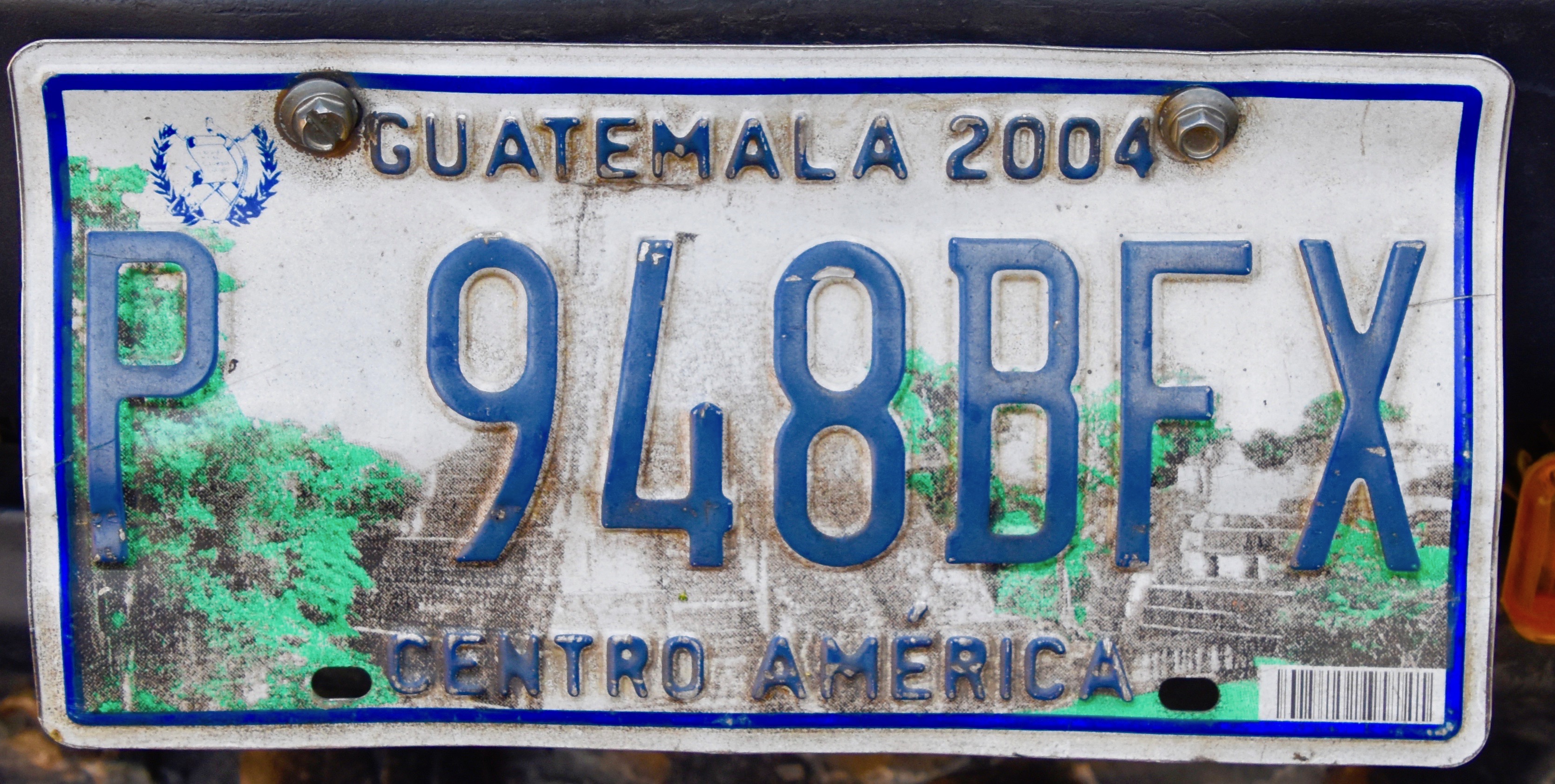
The one thing I have learned on this great trip so far is that no two Central American countries are alike. Despite our tendency to stereotype them all as Banana Republics, nothing could be further from the truth. I don’t need to go into detail on what makes each one different, you can read my posts from each country for that, but suffice it to say that Guatemala promises to be a completely different experience from where we’ve been and where we are going. There’s a number of reasons for that starting with the make up of Guatemala’s population.
Guatemala has by far the largest number of indigenous people of any of the Central American countries; fully 44% of the people are identified as such in the last census of which the overwhelming majority are Mayans. However, Mayans are not one homogenous group, but many sub-groups speaking many different Mayan tongues which are not dialects, but completely separate languages. This map shows the predominant language in different areas of the country. Although over 90% of the population speaks Spanish (Castilian) as a first or second language, the map shows that the country is definitely not a melting pot, but more a patchwork quilt.
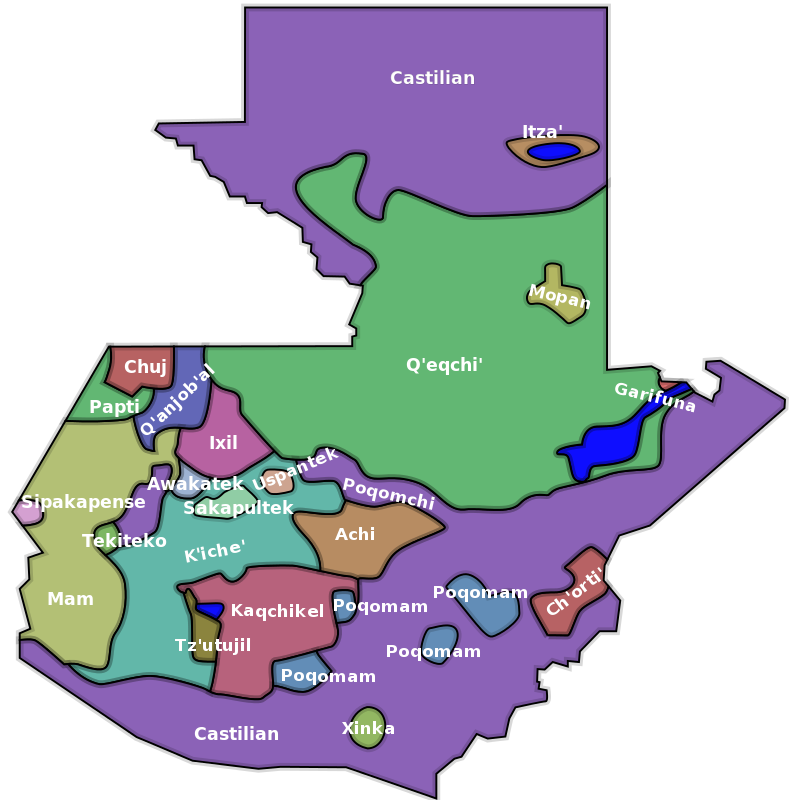
Guatemala has the most people of any Central America country – over 17 million and growing at one of the fastest rates in the Western Hemisphere. The average age of Guatemalans is only twenty and the number of people over age 65, less than 5%. Compare that to an average age of 40 in Canada with 16% over 65 and you have completely opposite demographic patterns. On top of that, Guatemalans average only 5 feet one inch in average height, allegedly the shortest in the world, so we are going to stick out like old, white, tall people in a sea of young, brown, short people. Should be interesting to say the least.
Guatemala also has the largest urban centre in Central America, Guatemala City with a metropolitan population of close to four million and growing exponentially due to the high birth rates and rural migration. That rapid growth has led to the city becoming infamous for its slums or asentamientos of which La Limonada with over 60,000 residents is the largest outside Brazil in Latin America. It is a literal hell hole where many of the residents making a living picking saleable items from garbage that is dumped there. If you ever want to know why so many Guatemalans flee their country for Mexico, United States and even Canada, read Don Winslow’s great novel The Border . In part it tells the story of Nico, a young Guatemalan boy who lives in El Basurero (the dump in English) a thinly disguised La Limonada, and is forced to flee from the gangs that dominate and control the slum through intimidation and murder. His effort to get to El Norte is a truly amazing read and far better than Jeanine Cummins’ American Dirt which to my mind is a rip off of the former.
Where Guatemala is actually very similar to the other Central American countries we have visited is its history of repression, revolution, civil war and seemingly unending violence, largely funded by American interests. The main sport of the nation today seems to be trying and usually acquitting former politicians of all political stripes on corruption and even genocide charges. Despite this, tourism in Guatemala, at least before Covid -19, is booming compared to its southern neighbours, El Salvador and Honduras. However, it is restricted mostly to the capitol, Lake Atitlan and the UNESCO World Heritage city of Antigua as well as the Mayan ruins of Tikal. With the exception of Guatemala City, which we will drive through, we will be seeing all the other tourist hot spots. We will be led through Guatemala by the voluble Tony de la Torre who, as we will learn over the next few days, seems to know everyone in the country.

However, while Chichicastenango is not exactly unknown, it receives only a fraction of the visitors the other places do. So with that introduction to this sixth Central American country let’s get a move on.
The border crossing back into Guatemala from Honduras goes smoothly and before long we are back at the junction of Highway 10 and heading north to a left turn onto Highway 9 which will take us all the way to Guatemala City. The road conditions are surprising good and most of the major towns are by passed so we make good time. The countryside is quite pleasant with well forested rolling hills interspersed with agricultural valleys. This is not volcano country, but that will be coming up once we reach Guatemala City.
Victor makes no promises of how long it will take to get from one end of the capital city to the other. In places there are four lane or even wider highways and in others we are down to a crowded one way street with red lights seemingly every block. The traffic is far worse than any place we’ve been on this tour, but still nowhere near nightmarish. We do get stuck in a traffic jam a few times, but usually not for long. Most of the cars are reasonably new and some, like this pickup are carrying interesting cargo. Some lucky kid is going to have a ball smashing that piñata.
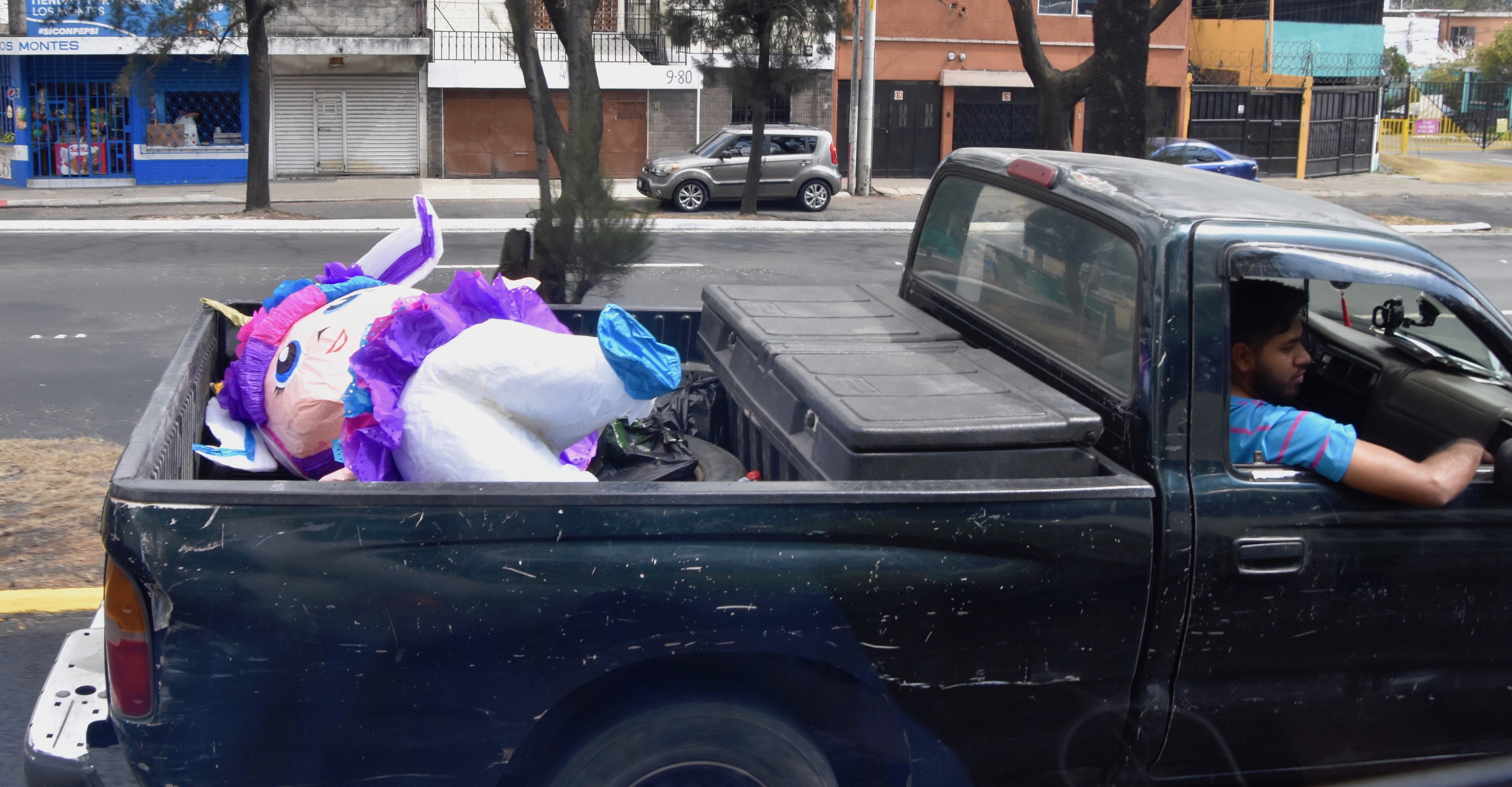
The most interesting thing I see in Guatemala City is the La Limonada slum which stretches for miles in a ravine which is crossed by the main highway a good 100 yards or more above it. It’s sobering to think that here we are in air conditioned comfort crossing over the heads thousands of people living in abject poverty below. I try to think up an appropriate analogy, but I can’t.
On the other side of the city the highway starts to climb steeply as we head into the Guatemalan Highlands and the volcanoes once again make their appearance on the left side of the bus. There is a steady line of about a dozen them that run all the way from Guatemala City to the Mexican border. The scenery begins to take on a distinct alpine appearance with many buildings made of huge wooden timbers. We also start to see a lot of the ‘chicken buses’ for which Guatemala is famous.
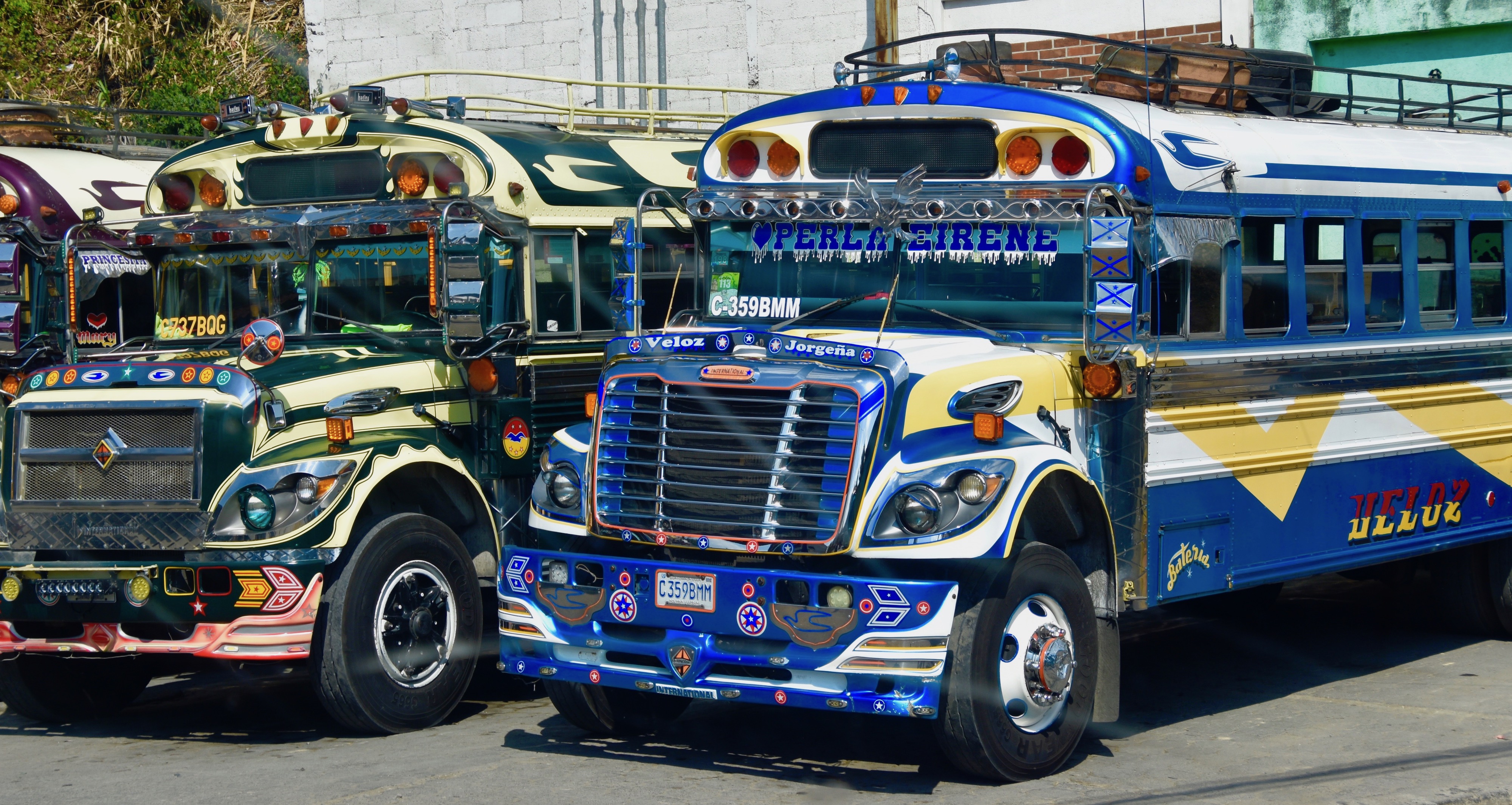
The chicken buses are so named because a lot of people bring their chickens on board, just like every stereotype you’ve ever thought of third world bus transportation. They are repurposed school buses from the United States and Canada (I saw few Bluebirds maybe from Brantford and New Flyers definitely from Winnipeg) that are the main means of getting from town to town in Guatemala, especially the highlands where most of the Indigenous population is based. They are outrageously decked out and fitted with motors that make them go like hell. The drivers put their faith in God and not their common sense so you see them sometimes passing on blind turns, careening around corners almost on two wheels and other not so safe maneuvers. Personally I think the name comes from the way they seem to play chicken with traffic coming the other way. I’m glad I’m not sitting in the front seat.
After what seems like hours we turn onto the road to Chichicastenango and the bus begins a painfully slow ascent up a high mountain pass and then down and up again. In places the turns are so sharp that the driver has to stop and back up to get into position to make the turn. Meanwhile the chicken buses come rushing at us as if they really are protected by God and I keep expecting to see one go hurtling off the cliff to a fiery death hundreds of feet below. The people we are seeing out walking the roads or riding one speed bikes, often in the middle of nowhere, are pretty well all Mayans, many dressed in traditional costumes which of course means they are not costumes at all, but their regular clothes.
Finally, well below us, Chichicastenango comes into view. Still it’s at an elevation of 1,985 metres (6,447 feet) so we’ve been pretty high up going over these mountain passes.
The Mayan Inn
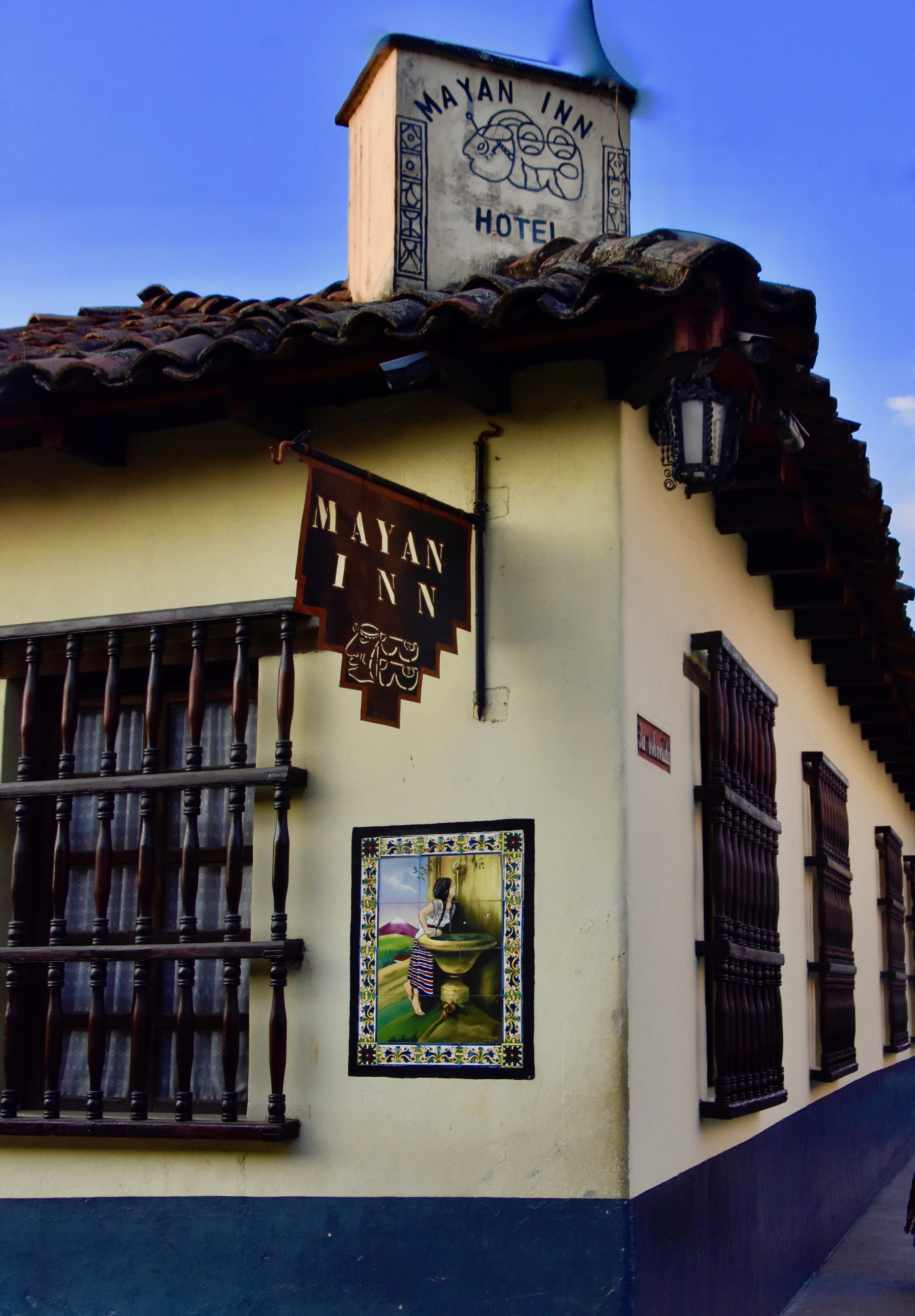
Our accommodation for the next two nights is the Mayan Inn and once again Victor has booked us into a place that has a perfect location in the middle of Chichicastenango, has a really nice ambience and is comfortable as hell. It consists of two complexes across a narrow cobbled street from each other and dates all the way back to 1932 when Guatemalan tourism was in its infancy and a fellow by the name of Alfred Clark acquired these properties and proceeded to fill them with art and artifacts of the Mayan Quiché (K’iche’) people who are the dominant group in the area. Our rooms are mostly in the building called the annex across from the building above where the bar and restaurant are located.
This is the door knocker for the annex.
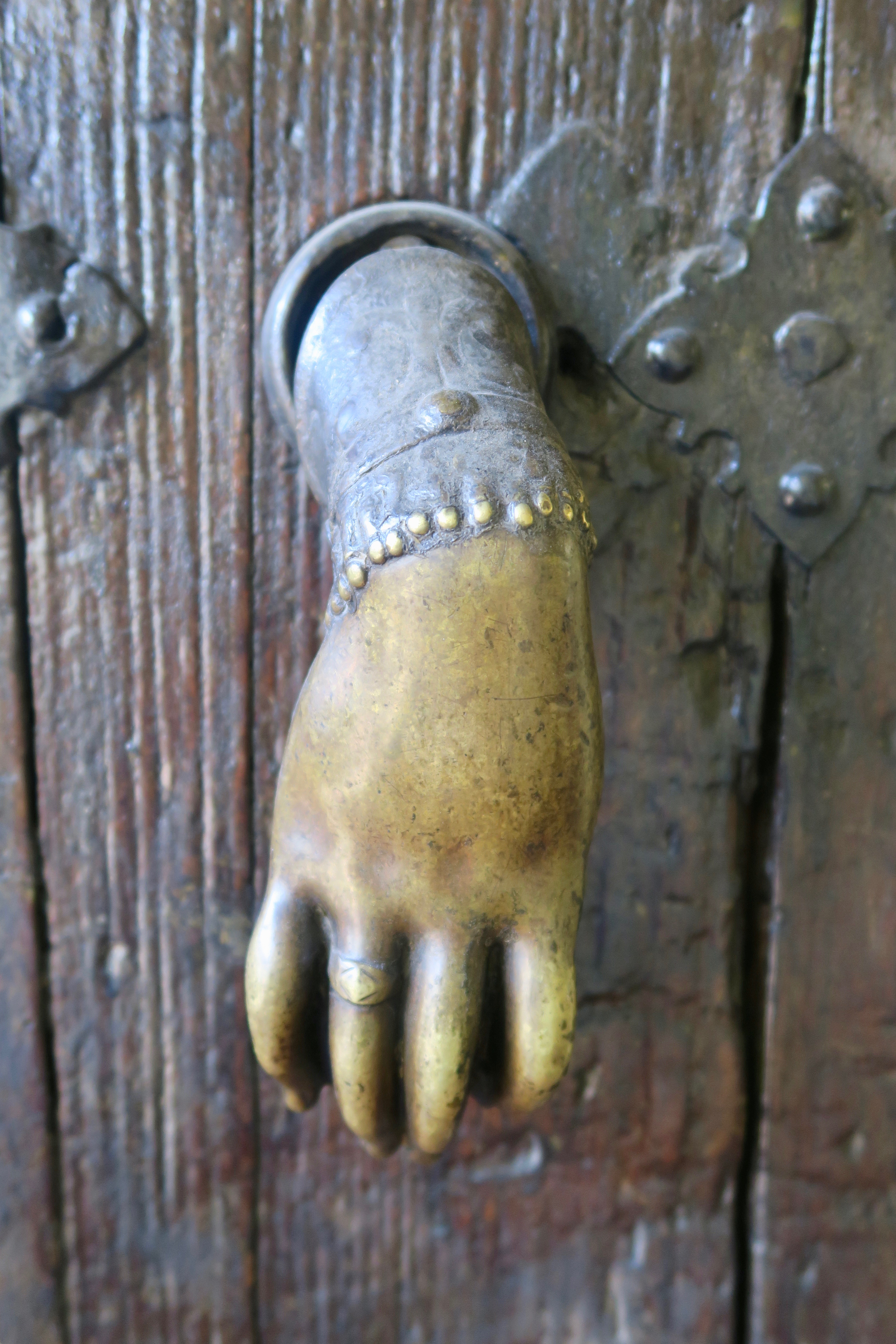
Inside there is a lovely central courtyard festooned with flowers where each morning a scarlet macaw and a green parrot are brought by their owner and places on perches for the day.
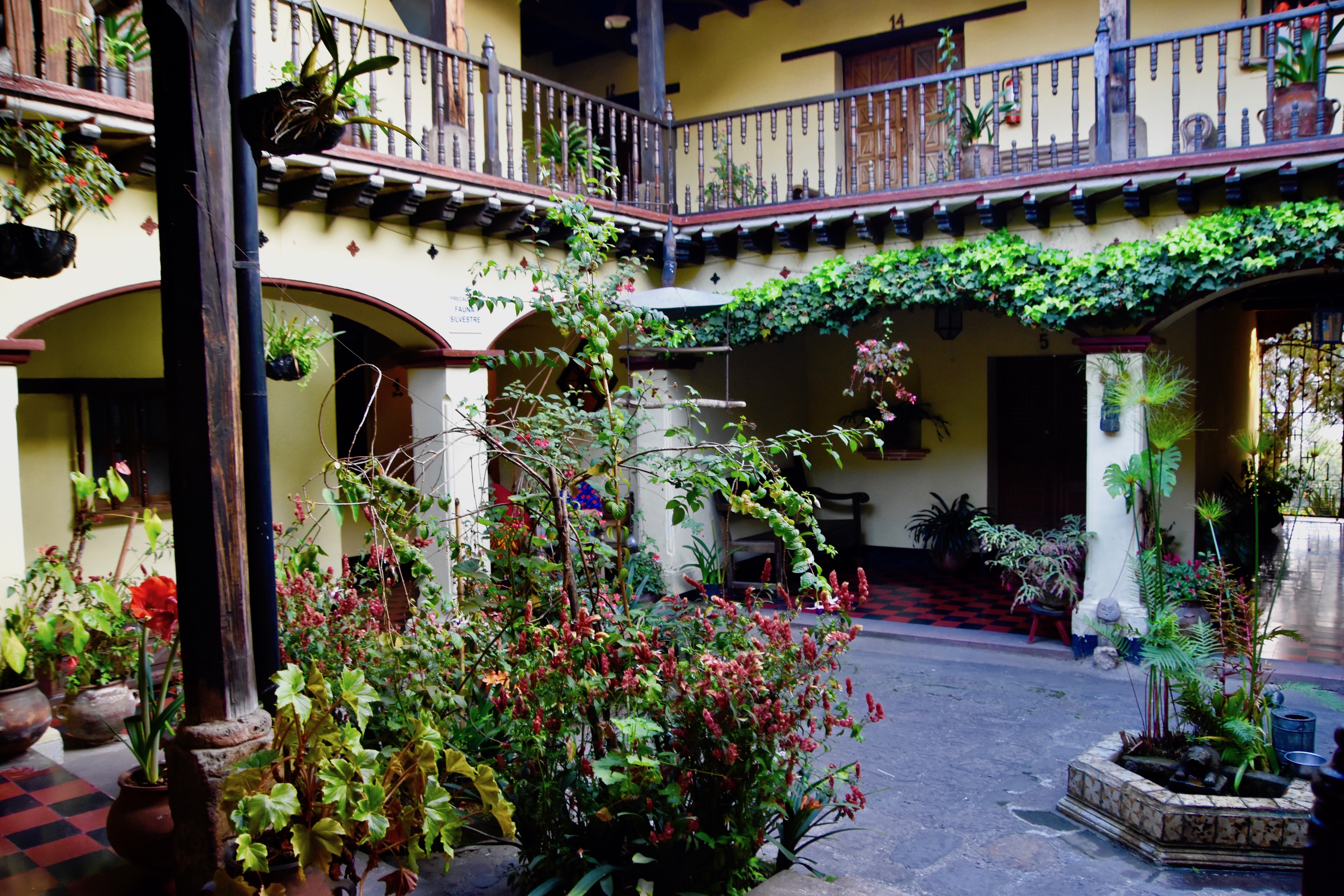
Every room is different and each has a working fireplace in recognition that it does get cold up here in the Guatemalan highlands. This is our room A 12.
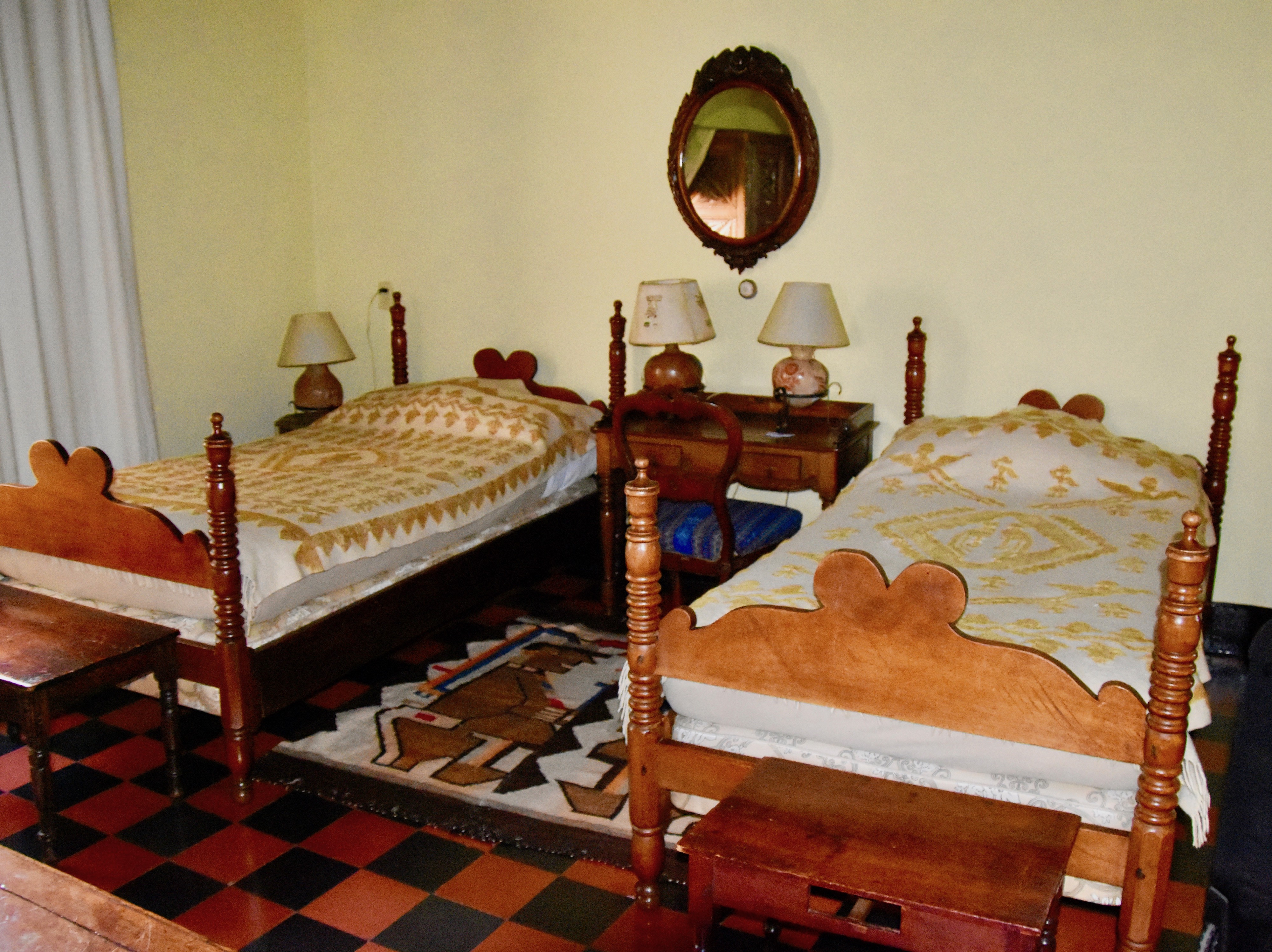
After unpacking there’s time to look around the place and its more like a museum than a hostelry, very similar to El Convento in Leon, Nicaragua. There are a number Mayan wall drawings with Mayan hieroglyphs above them interspersed with traditional Catholic religious icons such as you see above. This mixture of traditional Mayan religion and post Spanish conquest Catholicism was to become the ‘theme’ as it were of much of our visit to Chichicastenango and later the Lake Atitlan area. Although I am not a religious person, I have always been interested in learning about religious beliefs around the world and in particular syncretism, which is the combination of religions, often with almost diametrically opposite forms of worship, into a recognizable third type of religion. Probably voodoo or obeah are the best known examples to most people, but it exists throughout the world and one could argue that it is growing in Indigenous communities in North America where the revival of traditional religious beliefs is a definite trend.
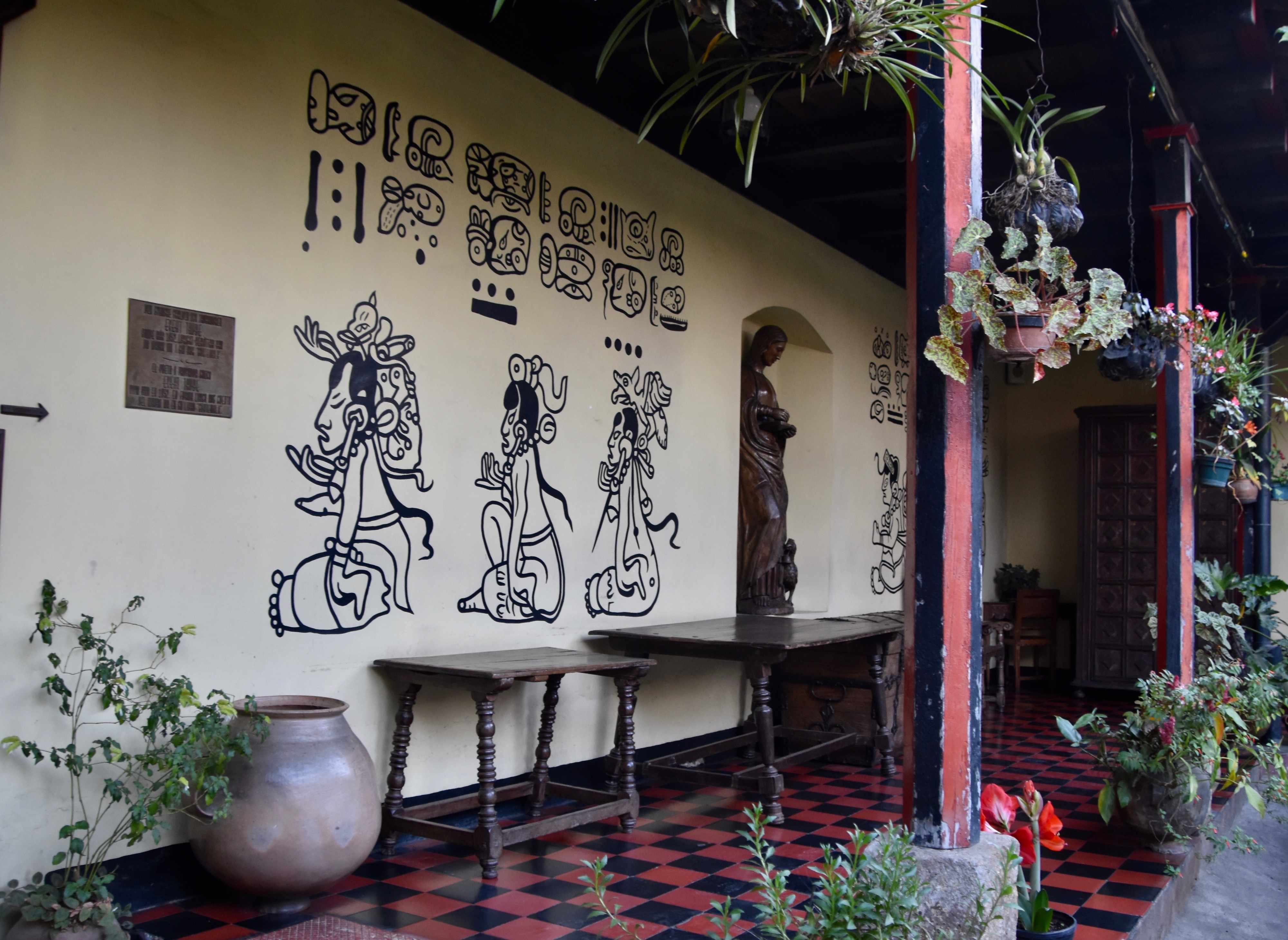
This is one of many paintings found on the property depicting people wearing the traditional Quiché garb with Chichicastenango in the background.

The courtyard in the main building is a riot of colour and there are a surprising number of twists and turns in what turns out to be a very large inner compound.
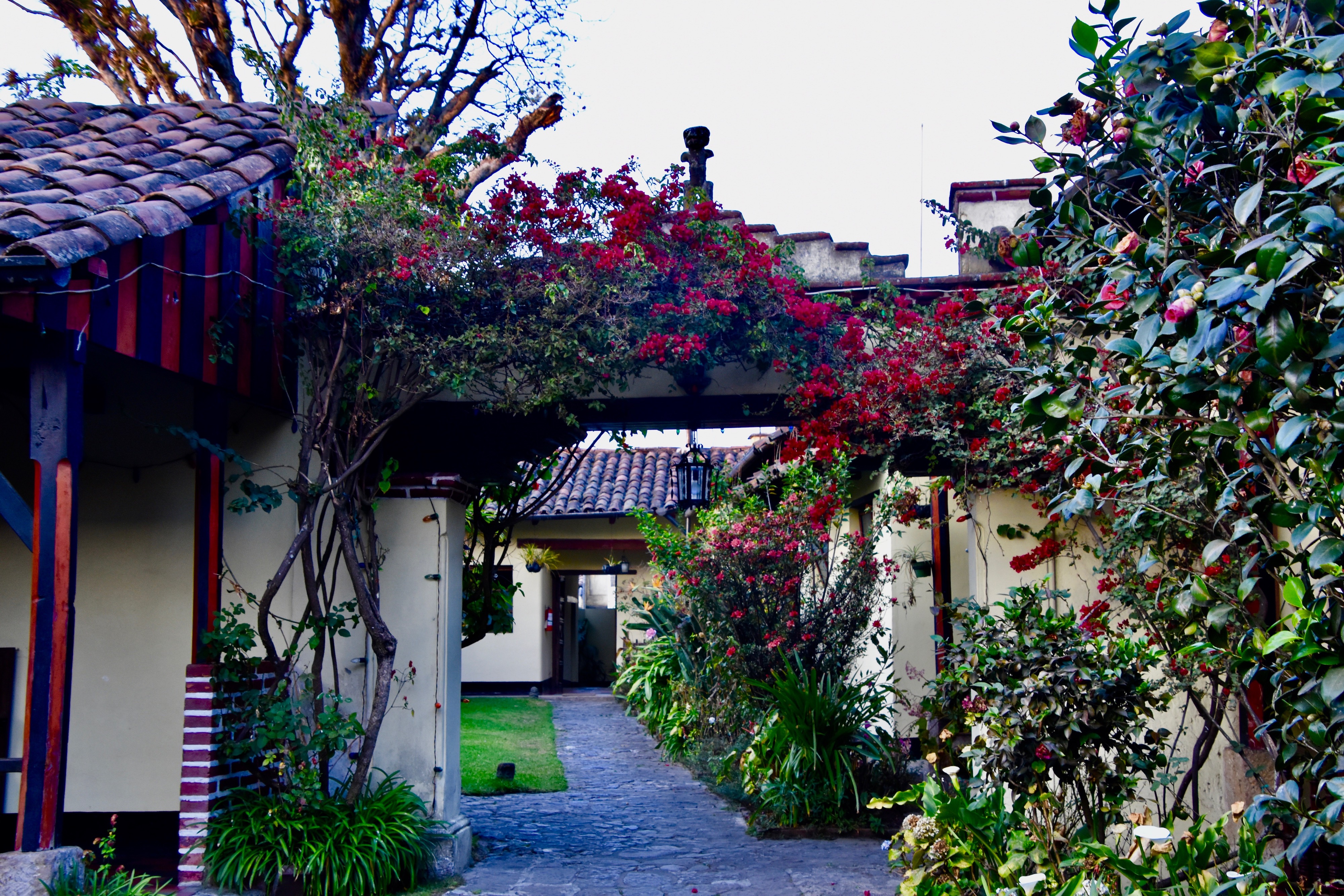
It was only on about my third reconnaissance of the property that I took a turn that took me out to another courtyard from whence this view. That’s the Chichicastenango cemetery down below and I knew immediately I had to get a closer look.
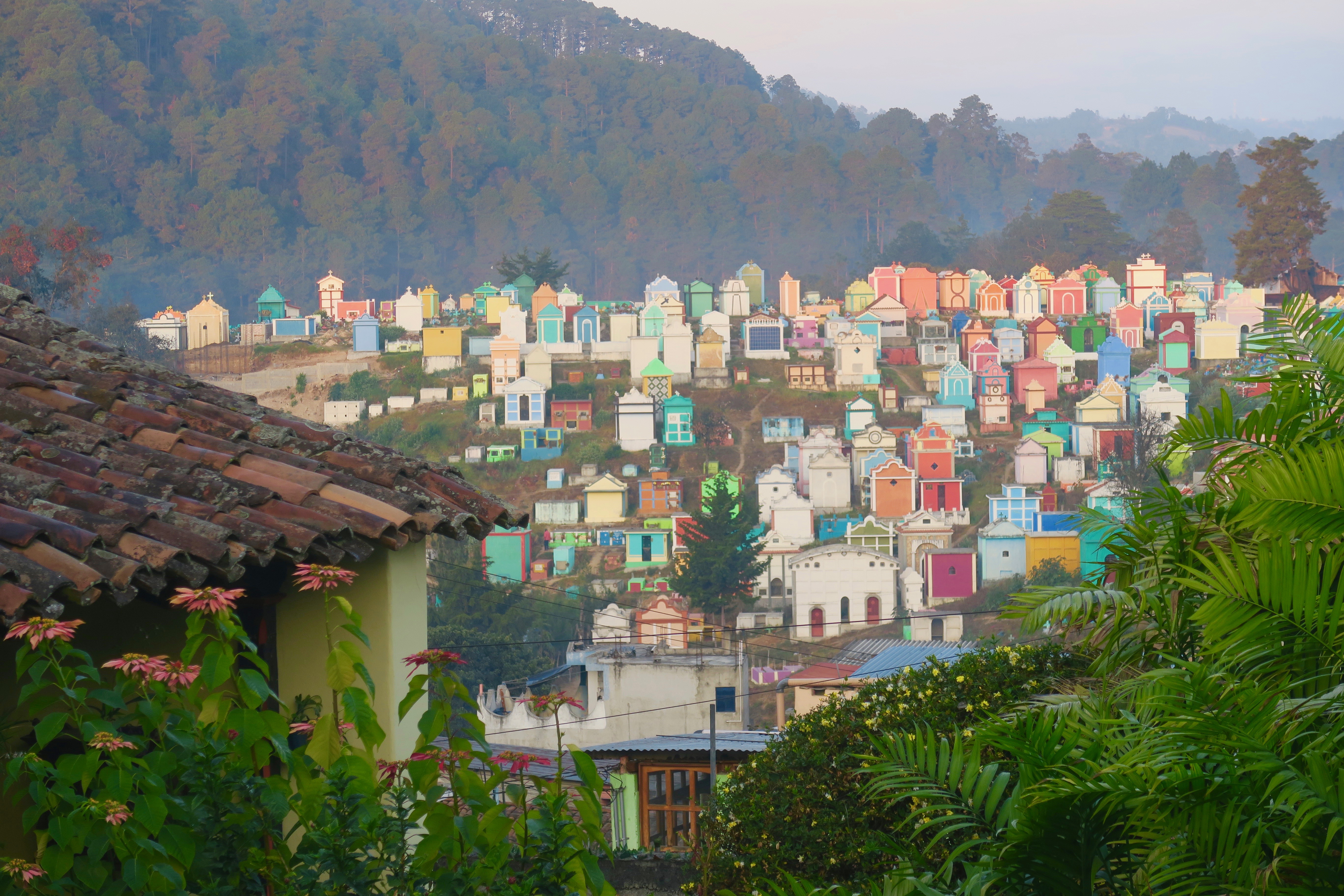
Chichicastenango Cemetery
I used the phrase ‘a stranger in a strange land’ earlier in this post and from the moment Alison and I stepped into the streets of Chichicastenango I have never experienced this feeling more strongly. The reason is readily apparent – we are like Gulliver in the land of Lilliput, towering above these really tiny people, the women averaging well under five feet. Also the fact that almost all of them are dressed in the same manner they would have been centuries ago, in colourful traje (dress), huipil (blouse), or corte (skirt) along with the tzute (head cloth) makes us, dressed in traditional modern costume, the real outsiders. However, it’s not an uncomfortable feeling. They just basically ignore us.
My first question upon arriving at the cemetery and seeing this sight is, “How the hell can they afford this?”. After all Guatemala is a poor country and some of these tombs are as big as small houses. The answer apparently lies in that combination of Mayan and Christian beliefs. The Mayans very much believe in the practice of honouring the dead, in fact, failure to do so can lead to the soul being trapped between life and death and no one wants that.
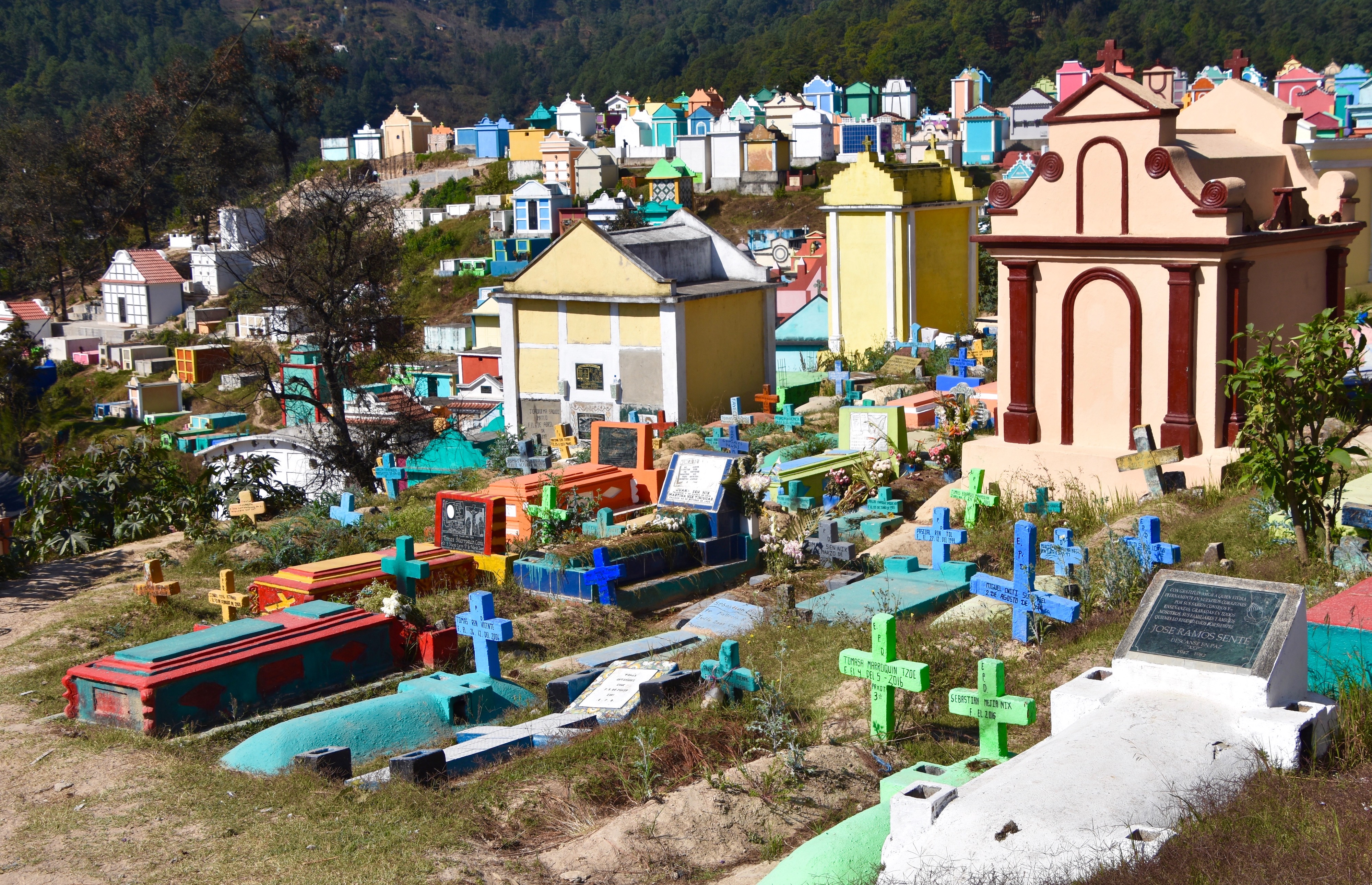
Every year just before the Day of the Dead ceremonies at the beginning of November, the families repaint the graves, whether they be mausoleums or simple crosses. The colours do have a meaning as well.
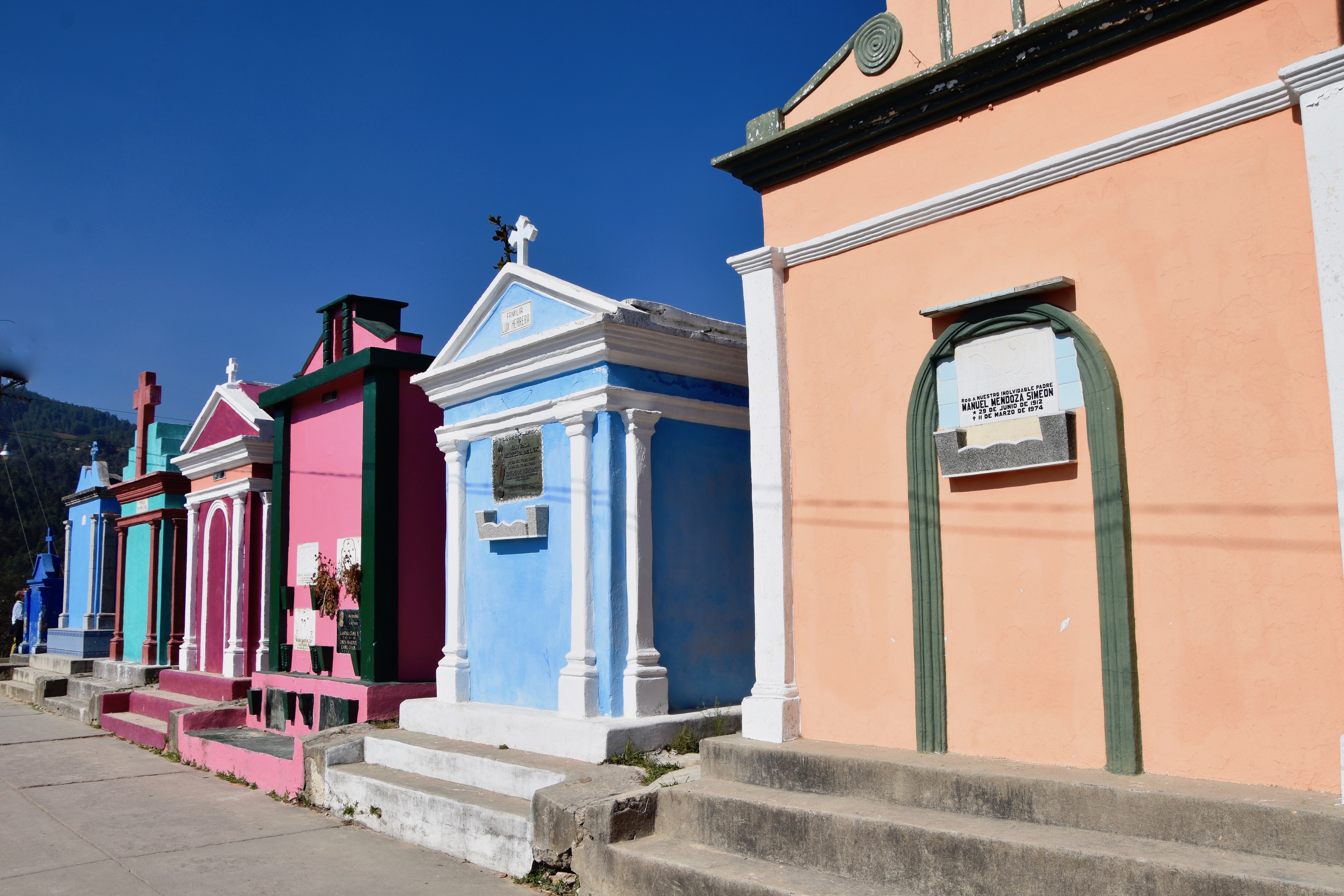
Some of the mausoleums are works of art in themselves.
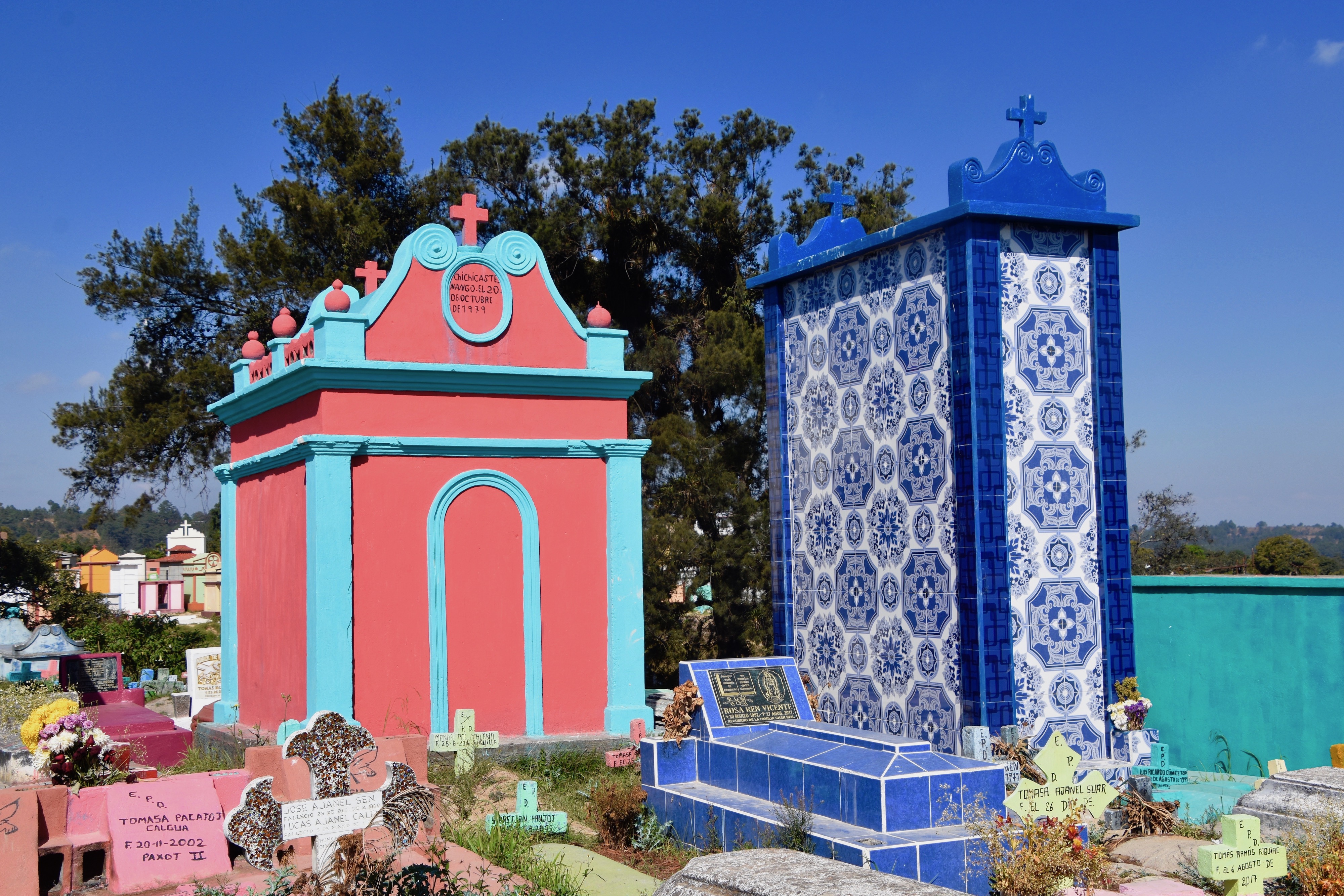
Others are dedicated specifically to one individual and reflect that person’s overriding passion in life. In this case car racing apparently as there is a miniature race track incorporated into the structure.
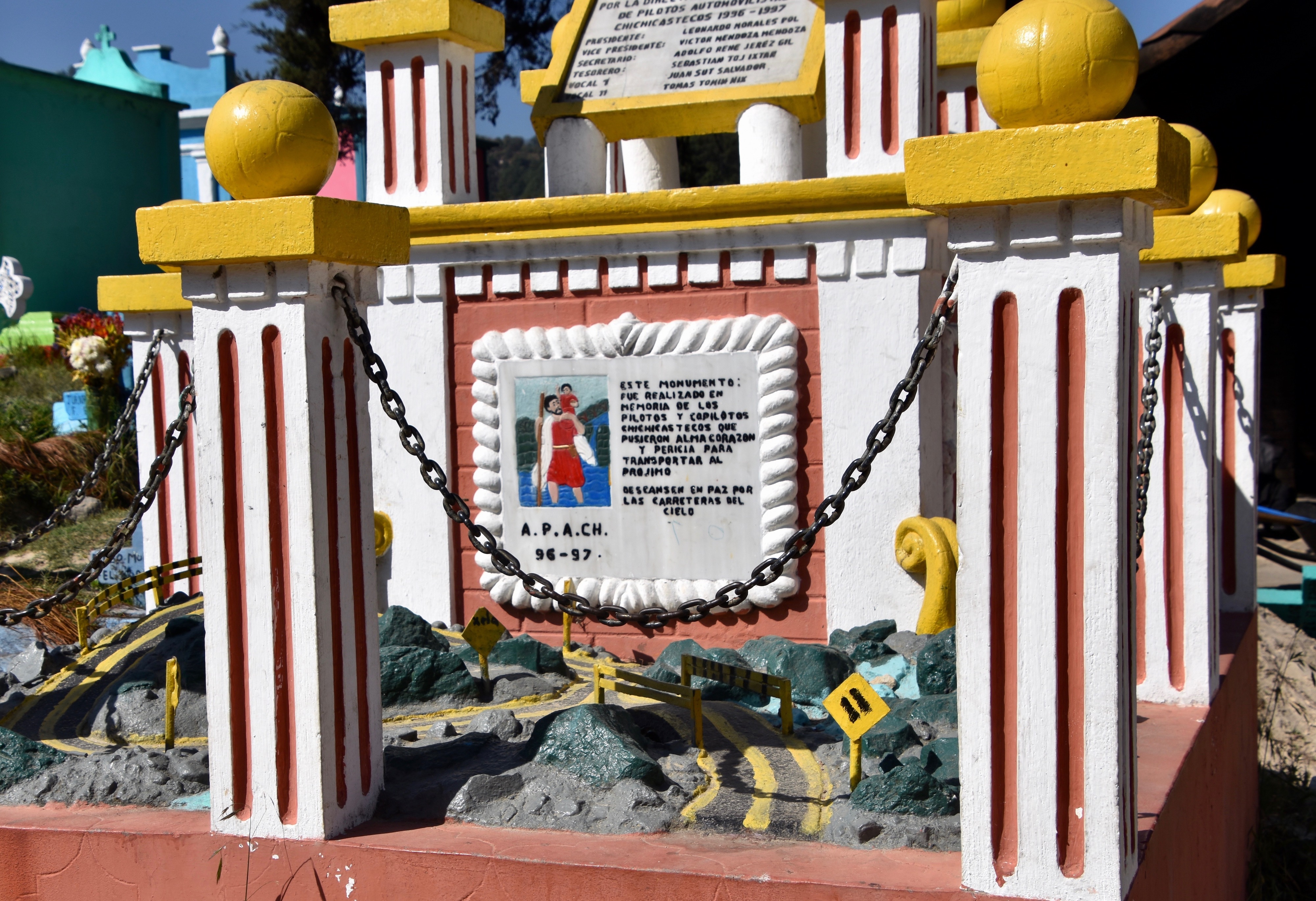
Obviously not every person in Chichicastenango has the means to afford a grand mausoleum, but the simple painted crosses in their varying colours are almost as interesting and photogenic.
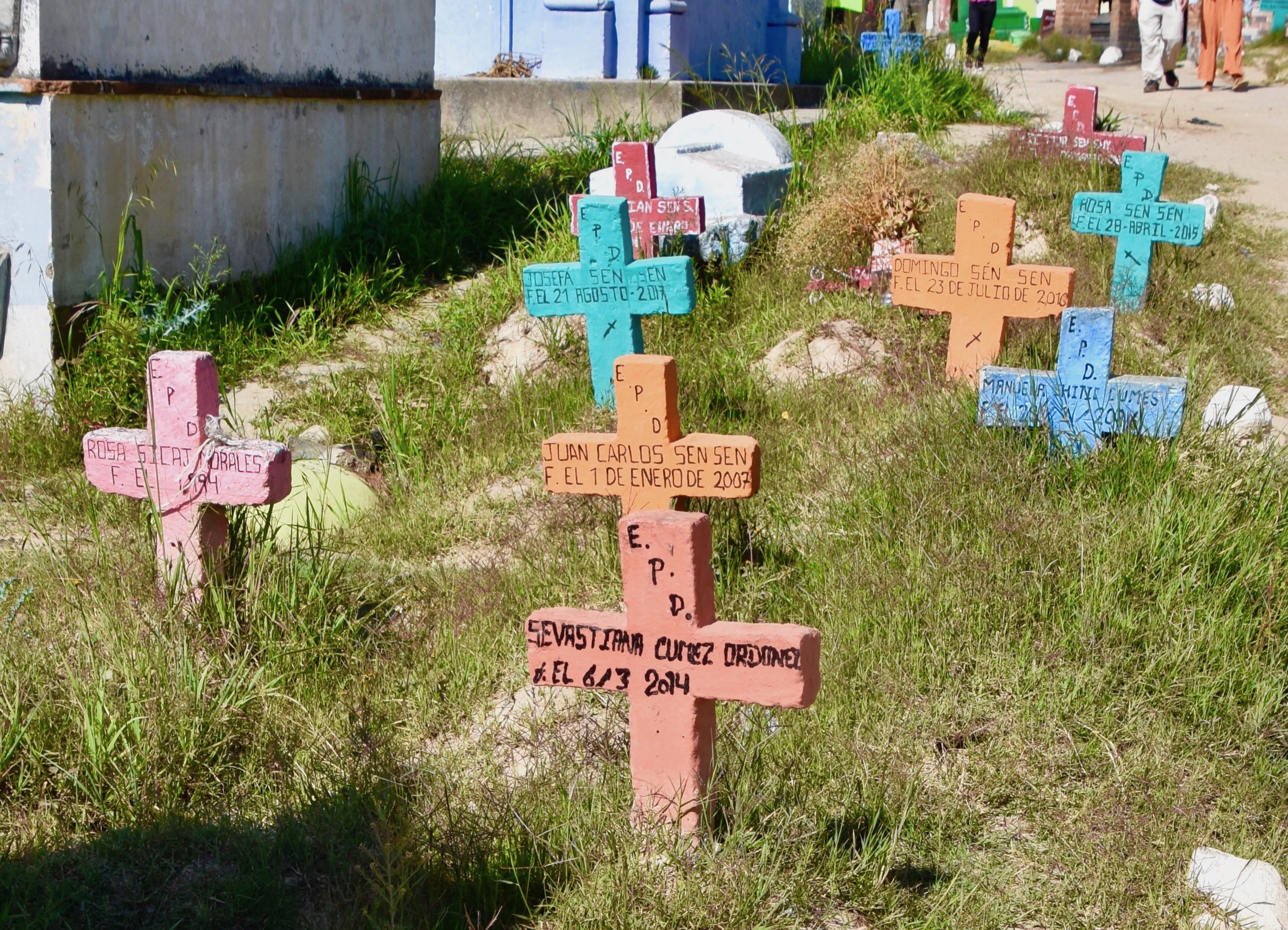
What I did not take a picture of in the Chichicastenango cemetery was the most interesting thing we saw there. At the highest point in the cemetery there is a flat covered concrete floor which is there specifically for sacrifices. Now the word ‘sacrifice’ has many connotations and the pre-Columbian Mayans practiced many of them including human sacrifice. Post conquest, the sacrifices were toned down, but they have continued over the years with the addition of a few Catholic additions, especially candles.
There was a family who had gathered for a sacrifice which was a circular collection of offerings including modern Mayan essentials – food, alcohol and tobacco. Over the next few days we would see a number of Mayan sacrifices and all would involves these three elements. Along with dozens of candles, all this is lit on fire and prayers made while the sacrifice burns. It is a sacred moment for the family and not one that should be photographed without permission which the family was not giving. If we were feeling like strangers when we set out for the cemetery, watching this ceremony cemented the feeling.
Returning to the Mayan Inn we passed one of the churches of Chichicastenango and observed sacrificial fires on the forefront of the building. The combination of the cross and the ancient ritual of the Mayan sacrifice taking place in a supposedly Christian place of worship spoke volumes about the Mayan syncretic beliefs.
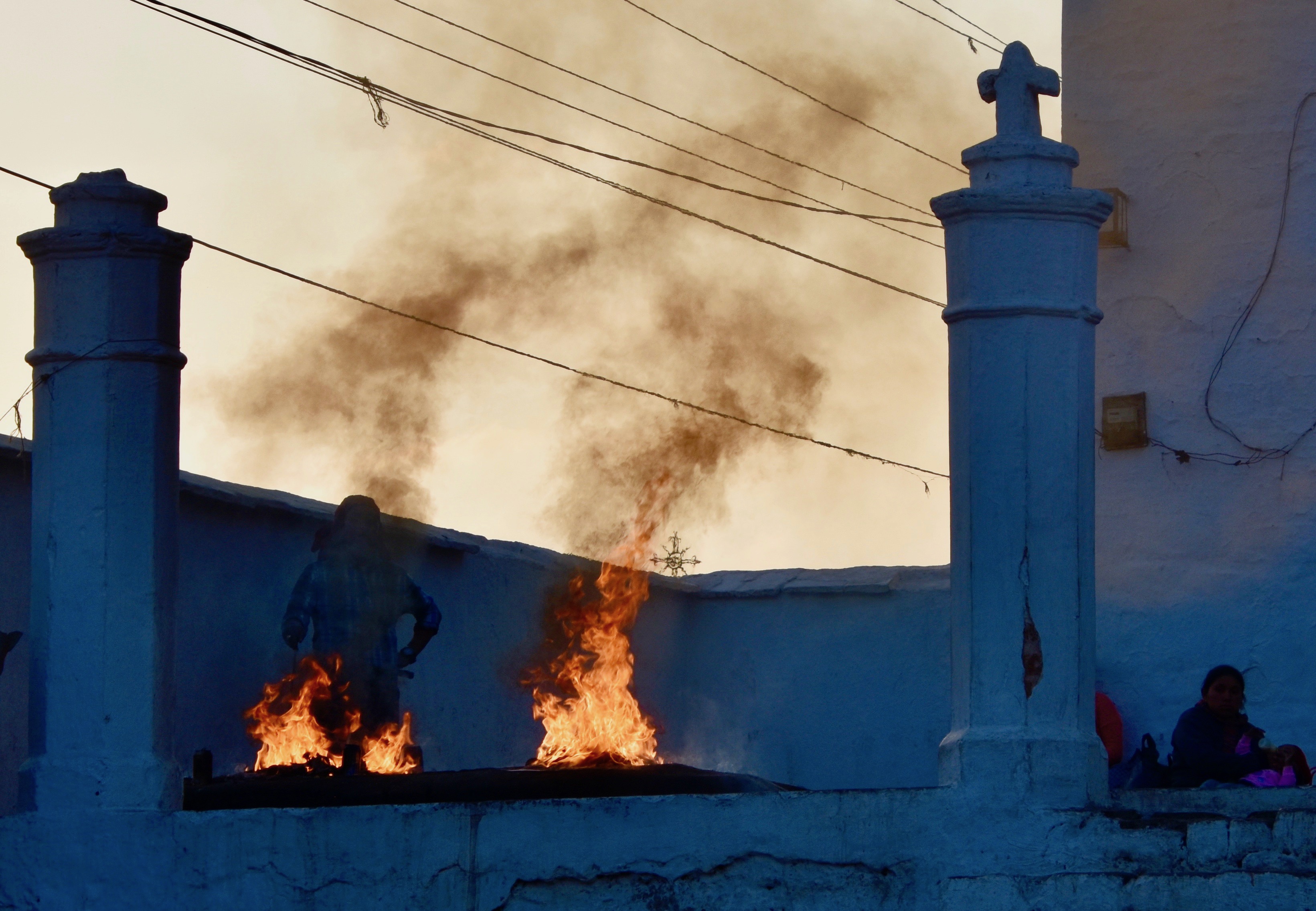
Back at the inn it’s time for a cocktail at the bar followed by dinner. Each couple has a man assigned to them during the stay who, dressed in Quiché garb, acts as both waiter and porter. This was our chap and I’m sorry, but I’ve forgotten his name.
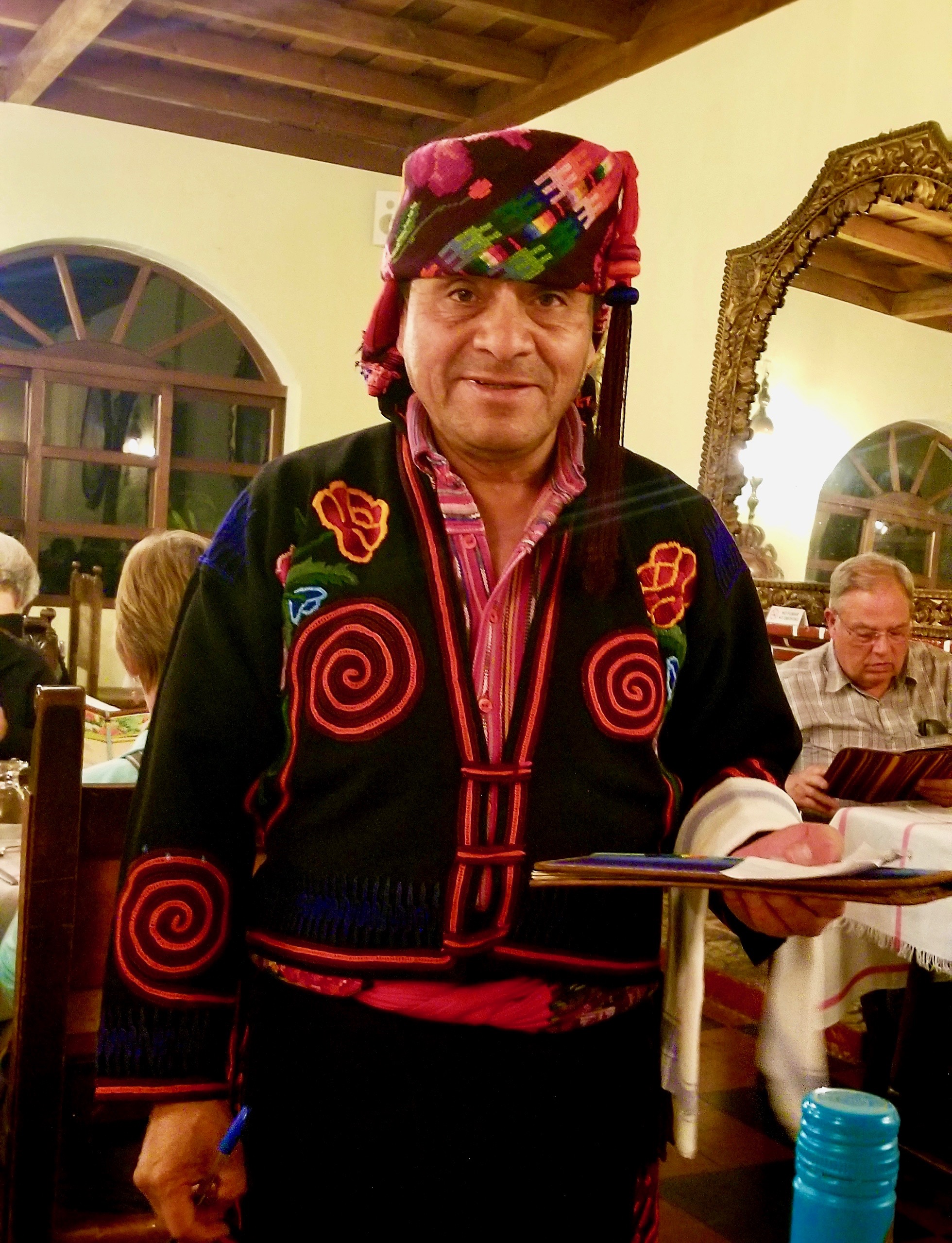
The dinner is vegetarian, which is actually a nice change, although I wouldn’t want to do it every night.
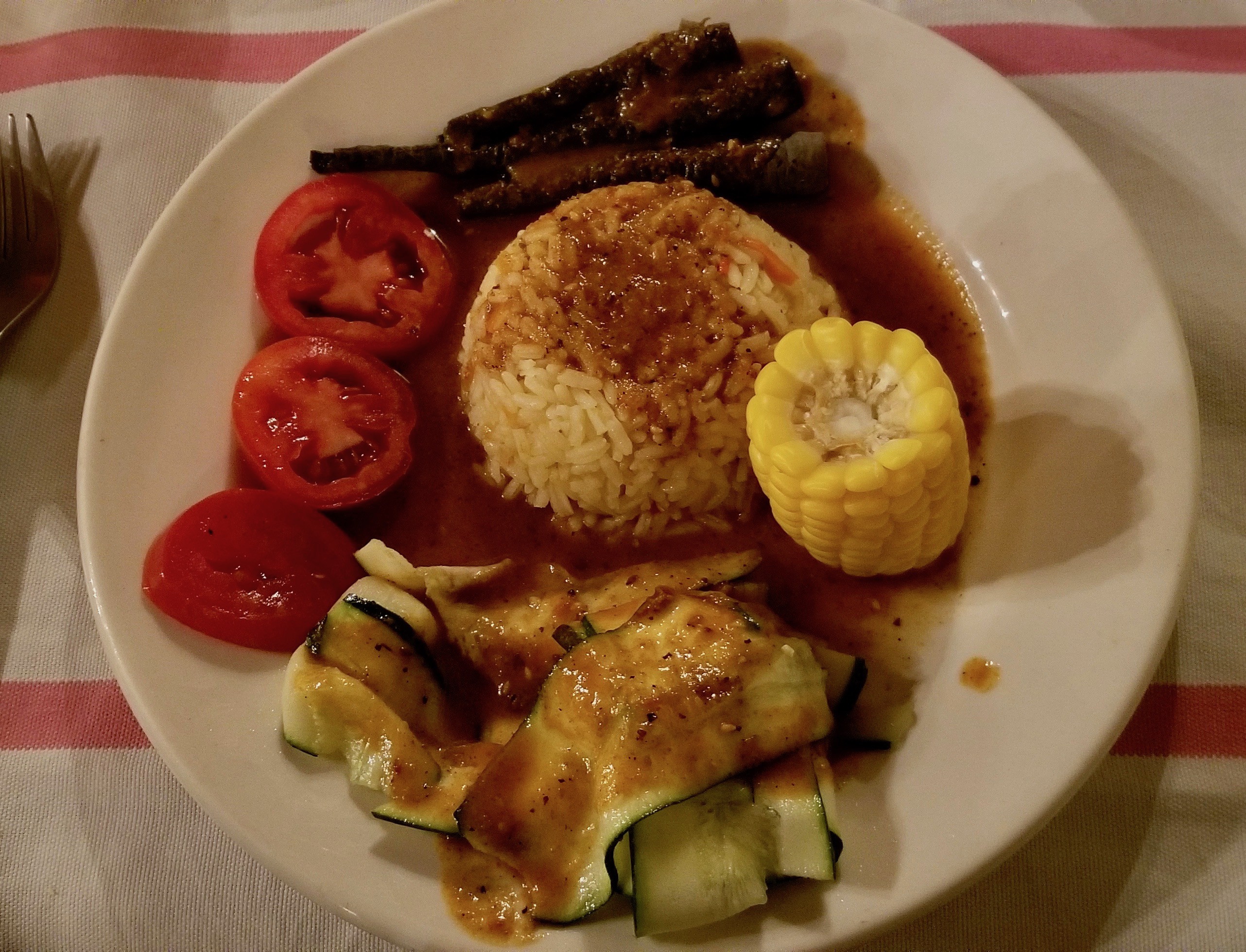
This has been one heck of a day, but I’m looking forward even more to tomorrow it’s market day in Chichicastenango.
Chichicastenango Market
I get up really early and go outside the Mayan Inn courtyard to see the preparations for the Chichicastenango market which has been held here every Thursday and Sunday for hundreds of years. It is the largest market in Central America and is a tourist attraction, but most definitely not a tourist market. The population of Chichicastenango and surrounding area is overwhelmingly K’iche’ Mayan and the products offered for sale are almost all primarily for the locals. The market spreads over a number of blocks and includes indoor and outdoor elements. It appears to be at the highest point in the town with the result that everything needs to be hauled up here, much of it by human foot power. I am amazed at the size of the loads that the people, mostly women, are carrying on their backs.
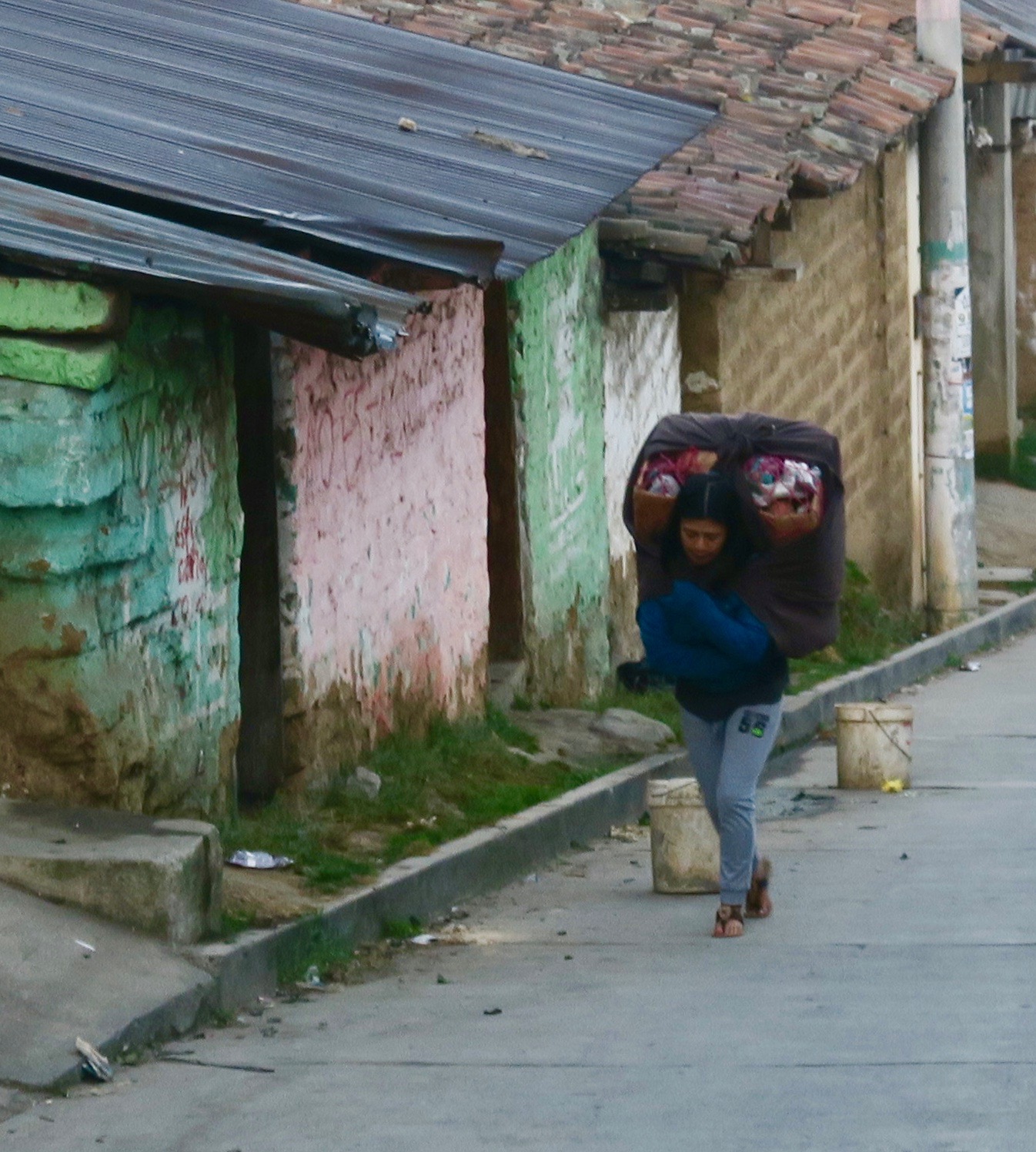
Back at the Mayan Inn a traditional breakfast awaits and then it’s off to explore the market.

Victor suggests checking out the poultry market which is in a closed street only a block from the hotel and it’s pretty interesting. The birds, which all seem to be remarkably fit looking, are kept in woven baskets covered with open netting that lets the birds move around, but not escape.
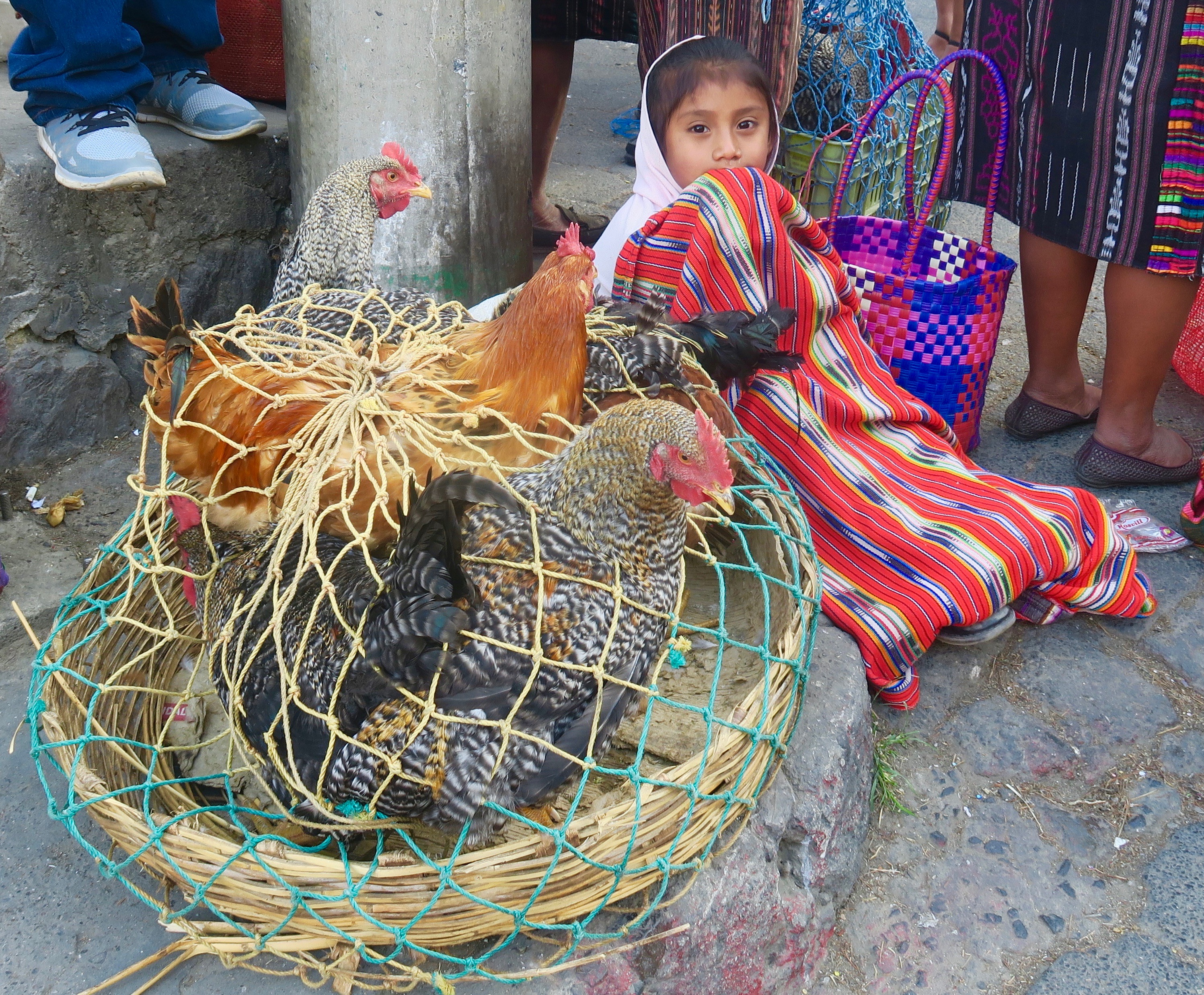
It’s not just chickens for sale, but ducks.
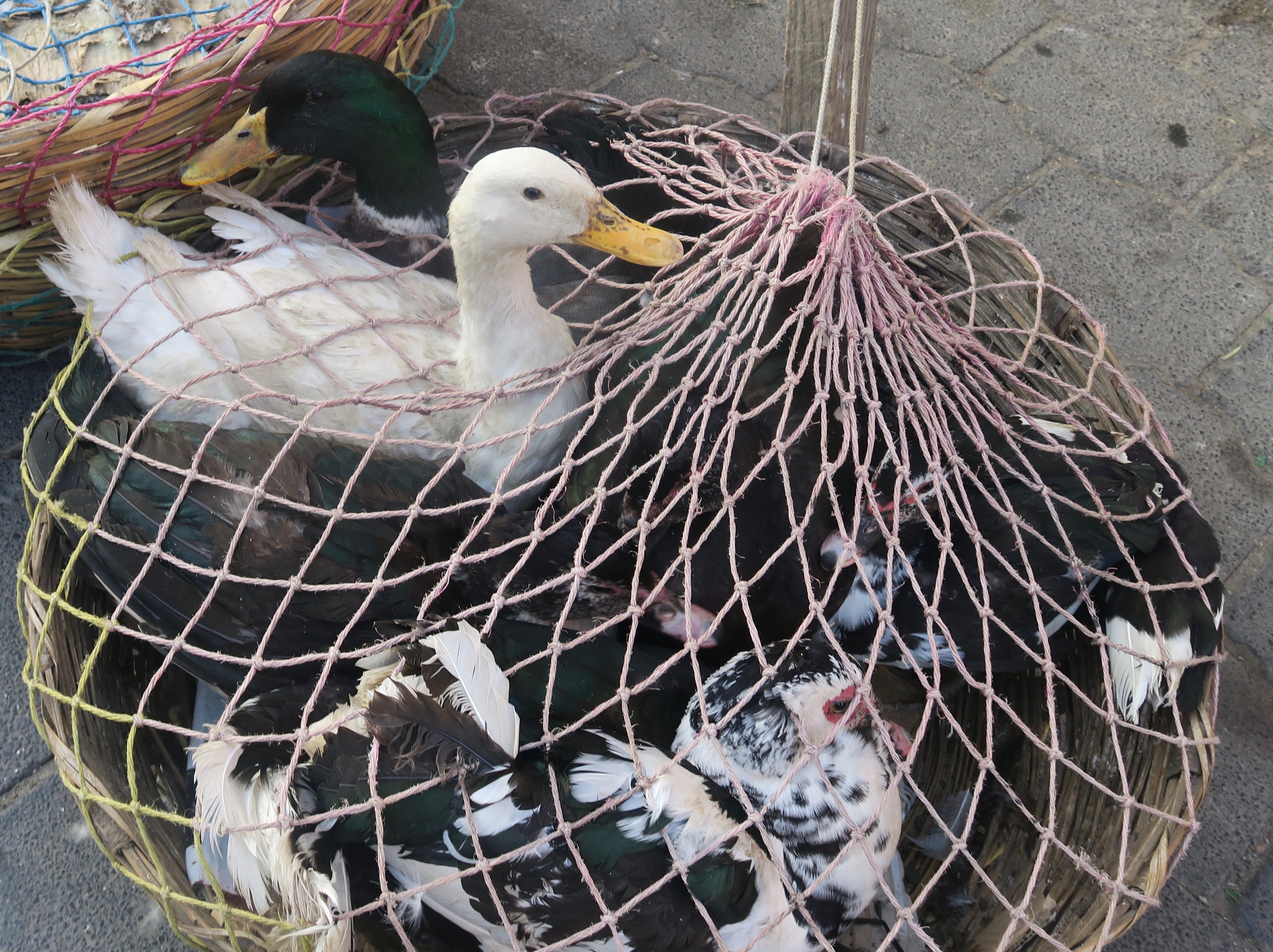
Turkeys
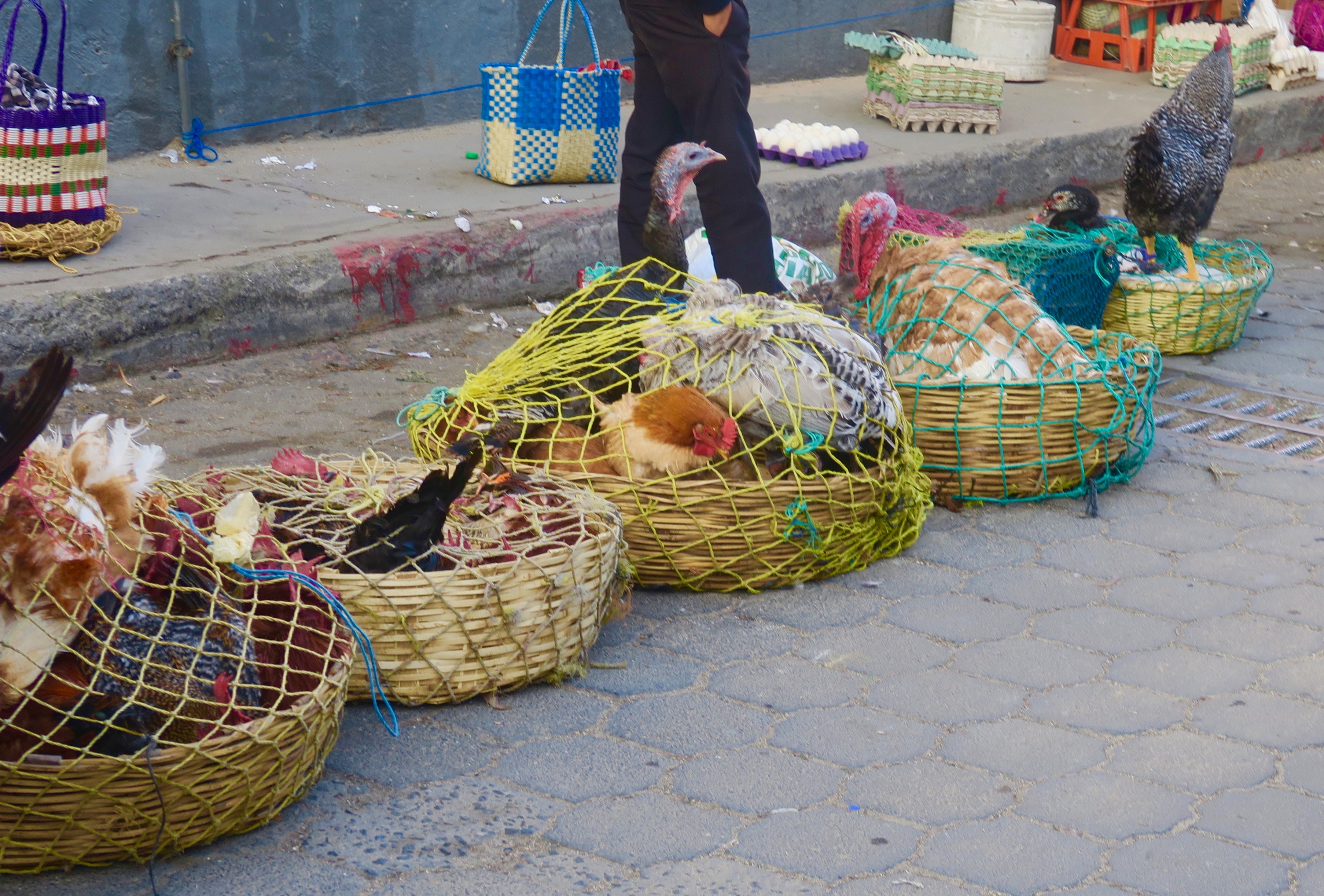
And chicks.
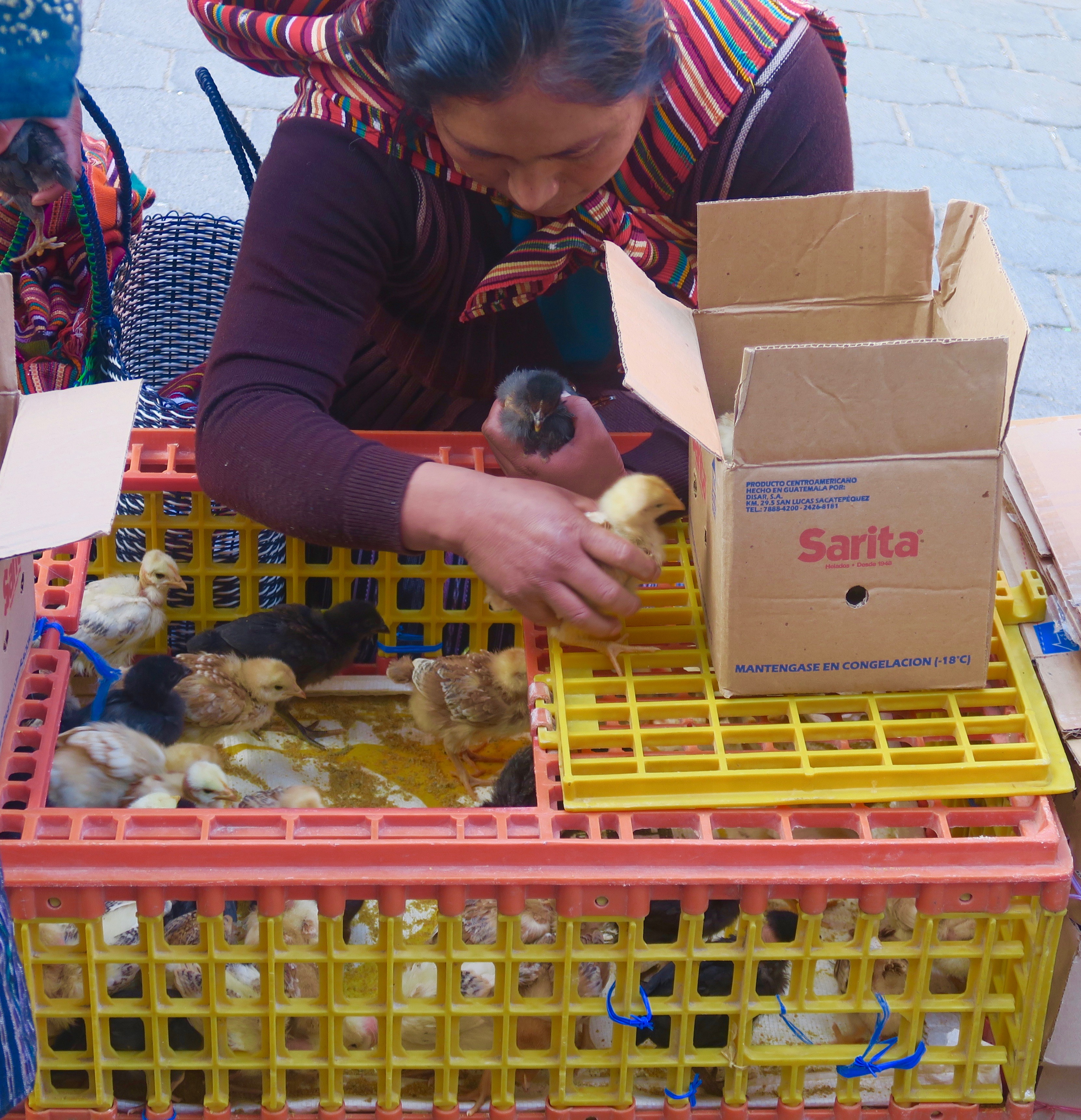
The most colourful part of a market world famous for its colours is without doubt the textiles, most of which are made locally and reflect traditional patterns that have been around for over a thousand years.
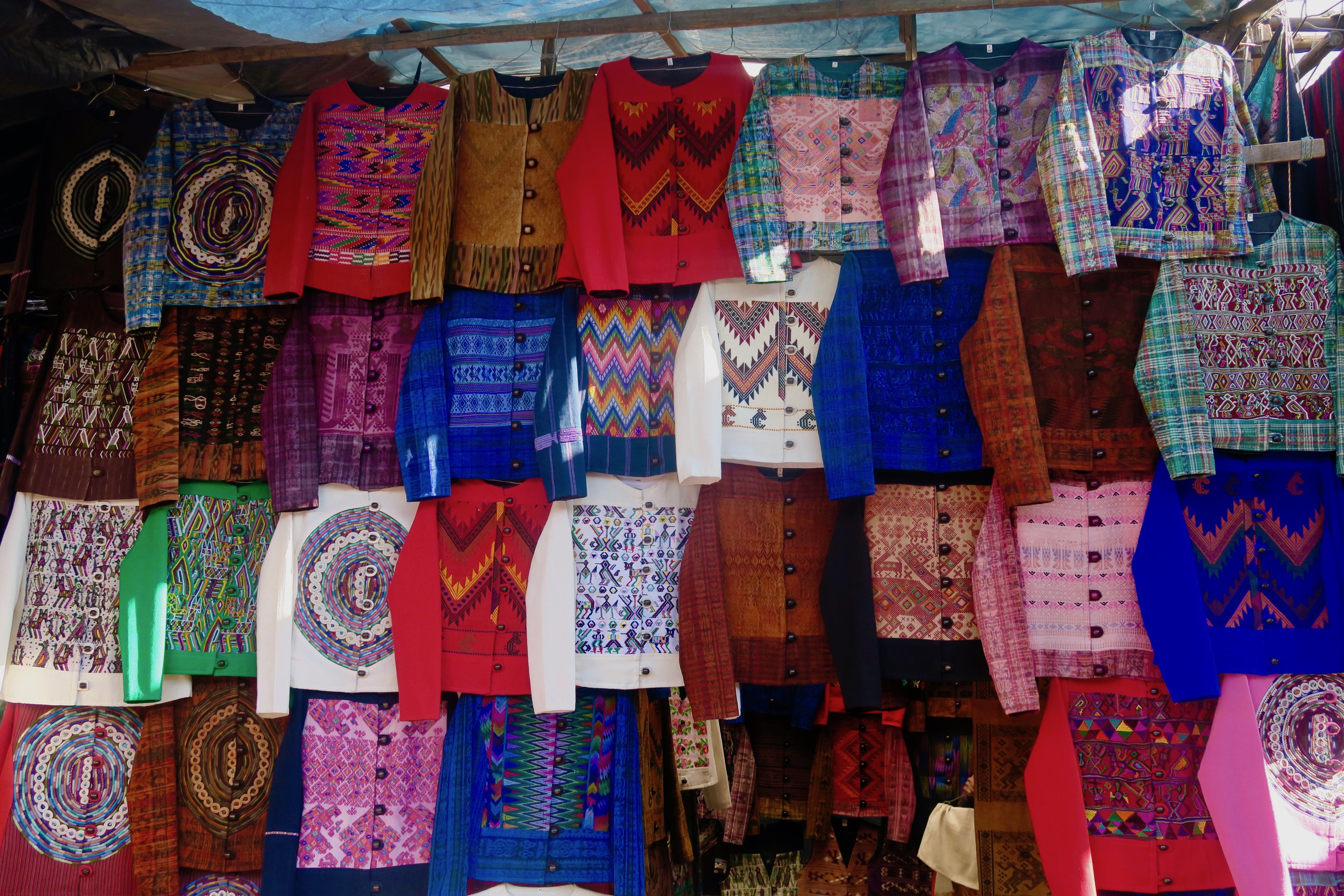

I walked by this stall where this guy was dressing his distinctly unMayan looking mannequins.
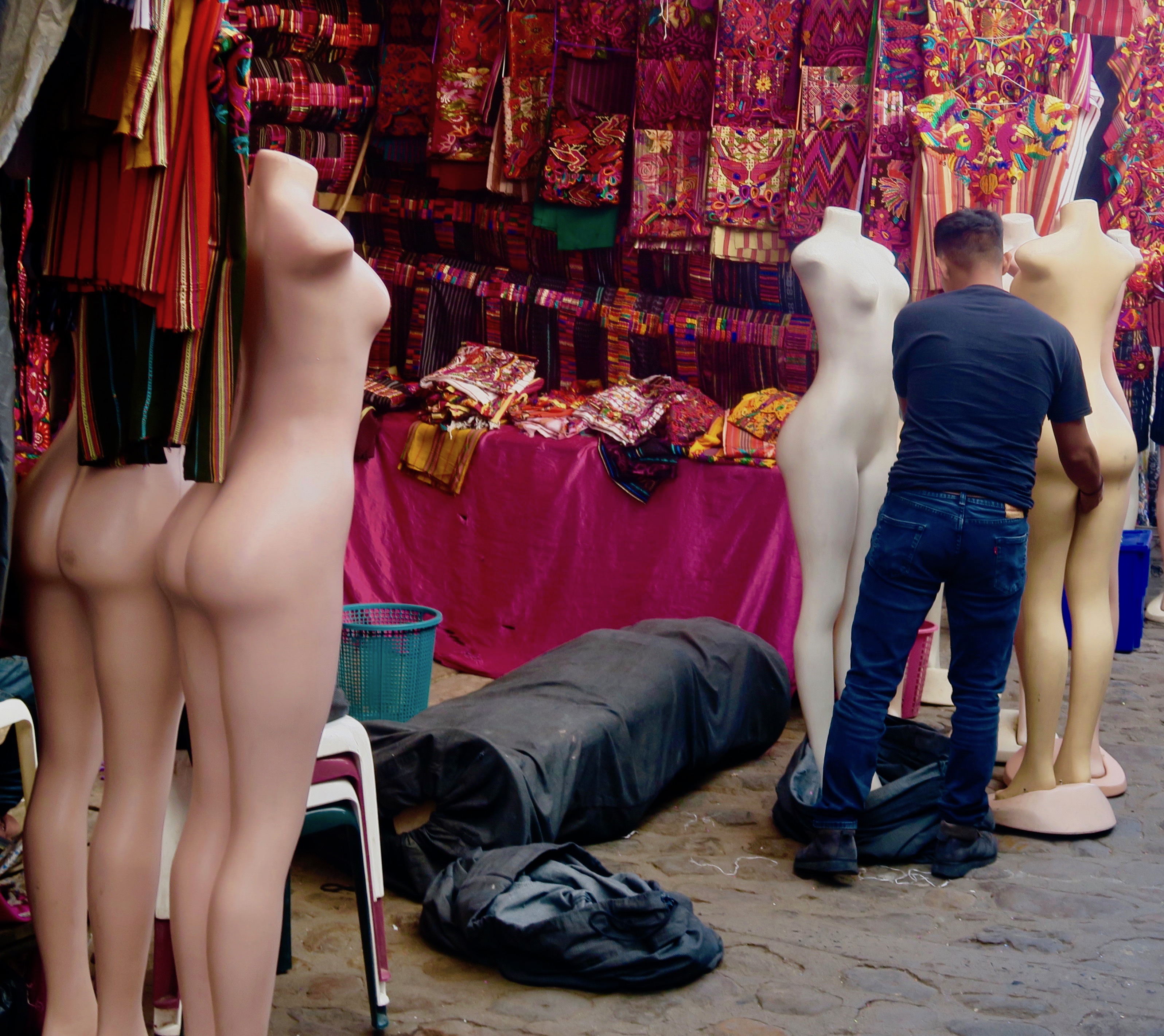
And returned five minutes later to see them decked out in their fionery.
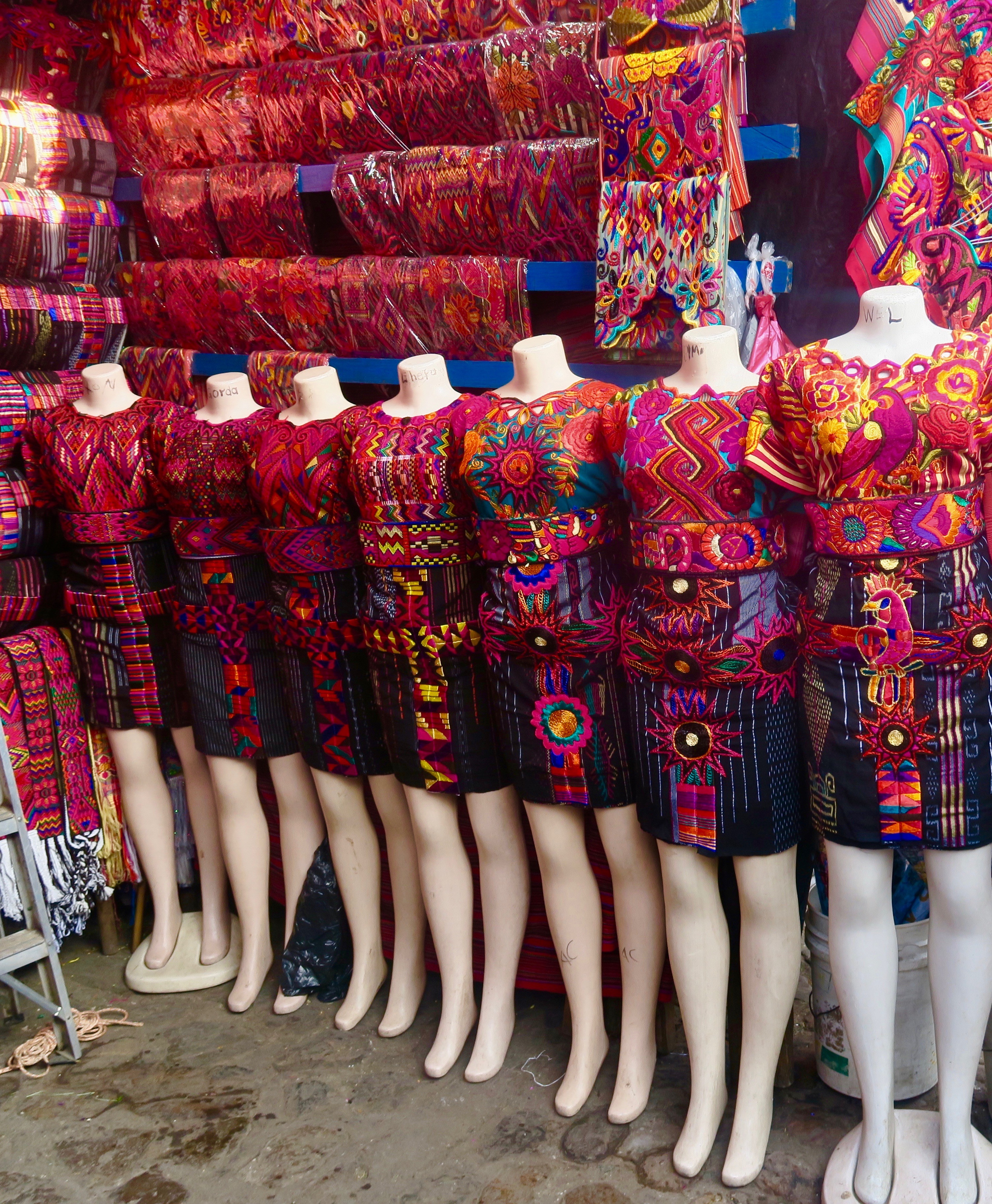
How about some aprons?
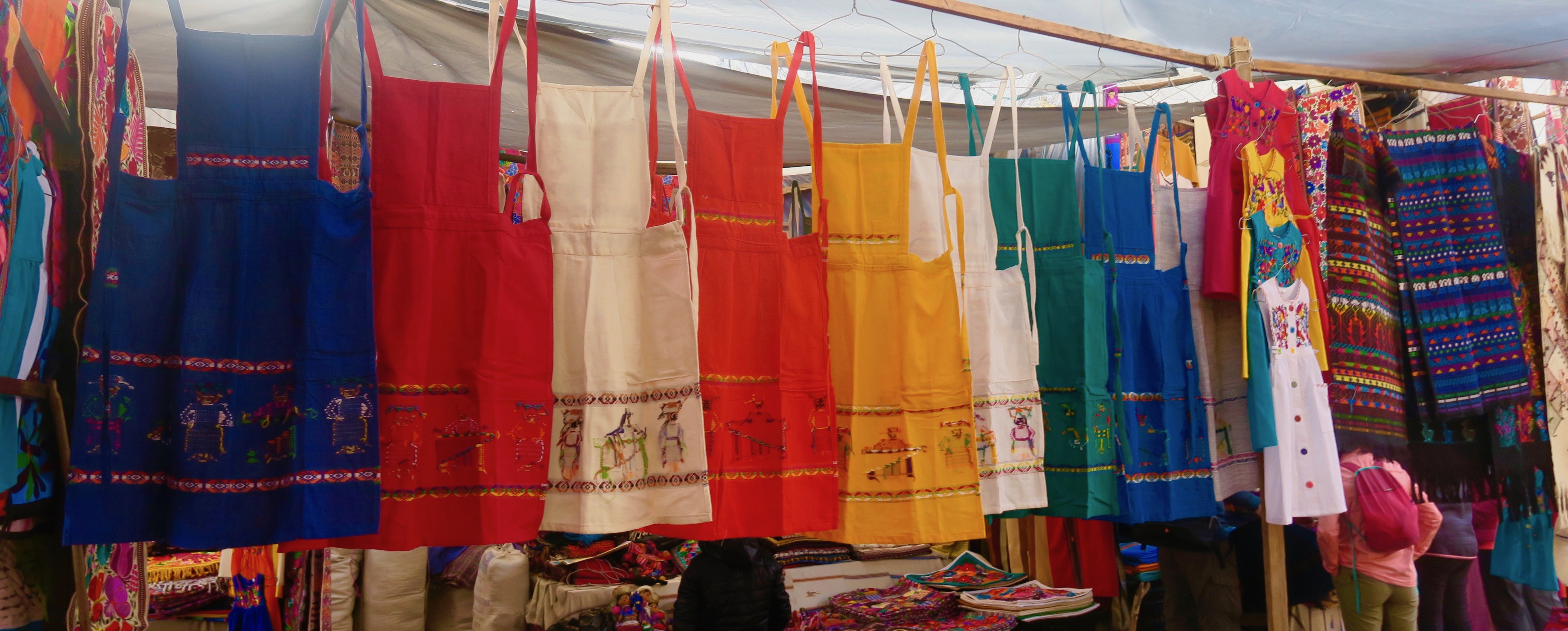
The Chichicastenango market is also well known for its pottery, which is not decorated for sale to tourists, but for every day use by the K’iche’ people. Again, there is a direct connect from these types of pottery and those used by the Mayans over two thousand years ago. By now the market was starting to get quite crowded, but there were no other tourists. Some did arrive later in the day by bus from Antigua or Lake Atitlan, but as far as I could tell the Adventures Abroad group was the only one actually staying in town which let us explore the market for the first couple of hours as the only tourists.
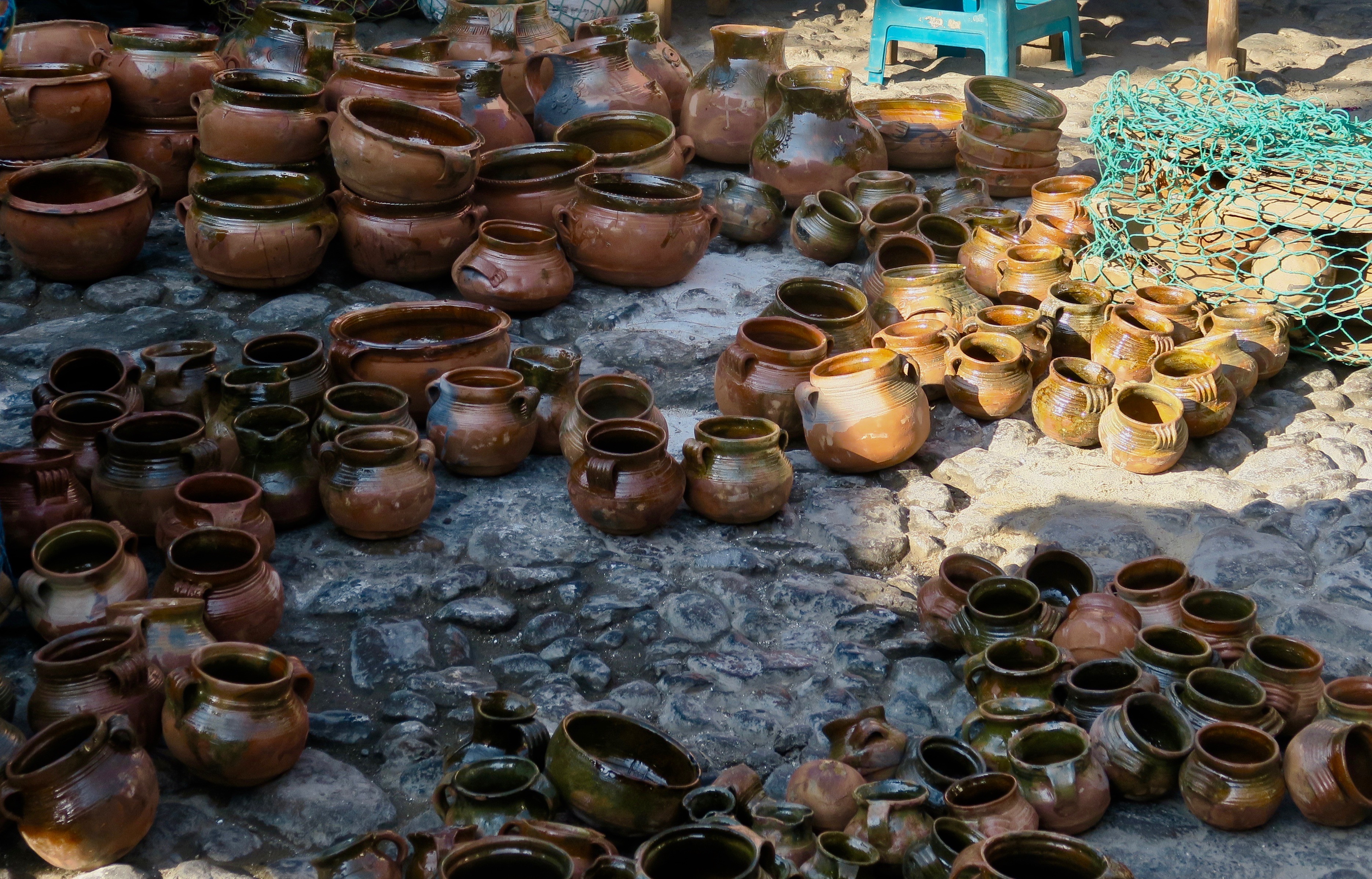
That stranger in a strange land feeling was continued in the market as there were so many items for sale that you would never see at home. Like this guy selling chunks of limestone. Say what?

In order to make tortillas you need corn flour and in order to make corn flour you need an alkaline substance, usually limestone, to use in a process called nixtamalization which makes the corn flour digestable by humans. The process has been documented in Guatemala as far back as 1500 B.C., once again directly linking this market to customs that are thousands of years old.
I had to pay this lady to take here picture and even then she refused to smile, giving me the evil eye instead. Considering that the Mayans very much believe in witches and she is making brooms, maybe I should invest in an appropriate talisman.
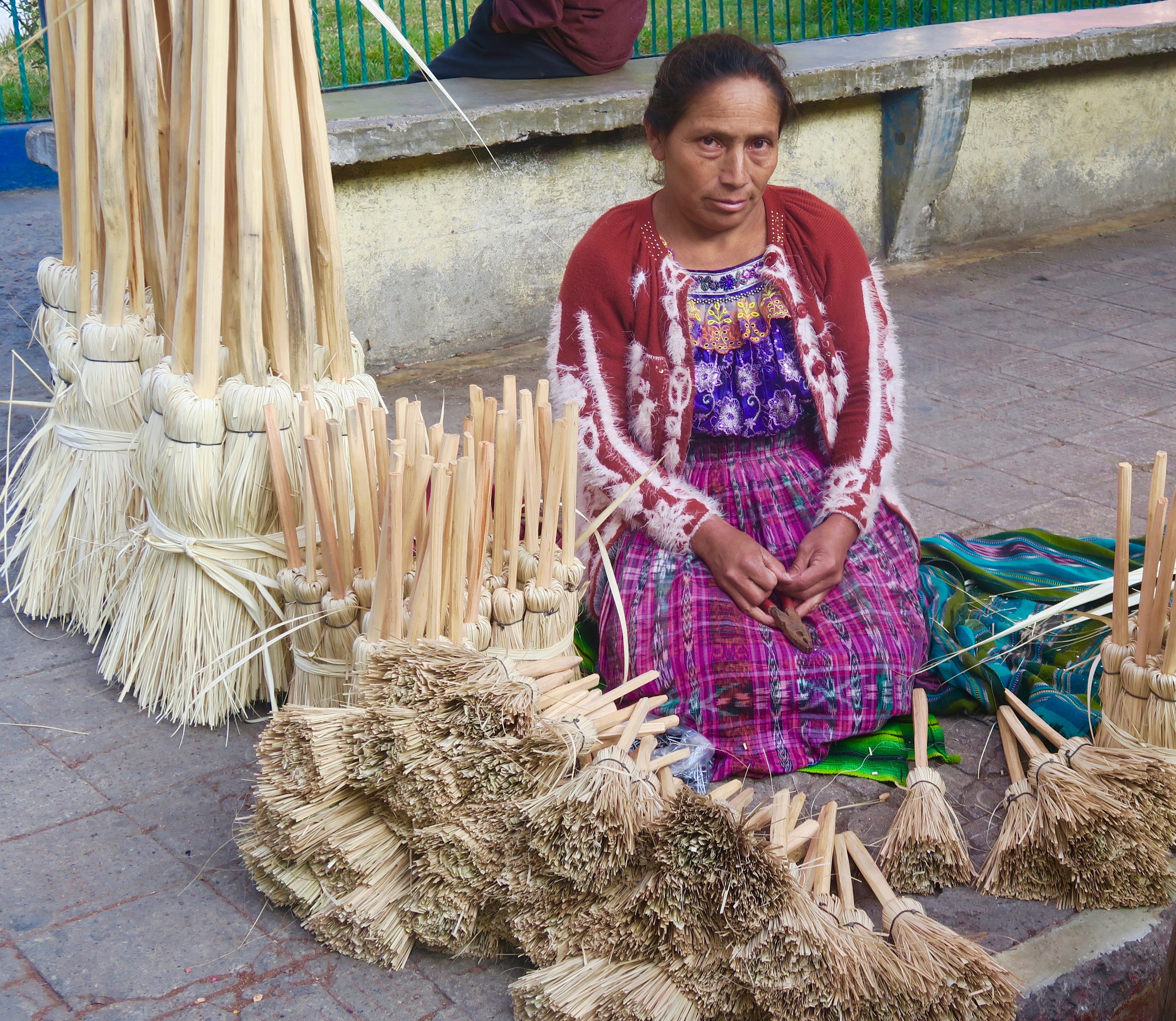
Flowers are always a popular attraction at any market, Chichicastenango being no exception with the flower market spread out on the steps of Iglesia Santo Tomás with the almost exclusively female vendors dressed in K’iche’ clothing.
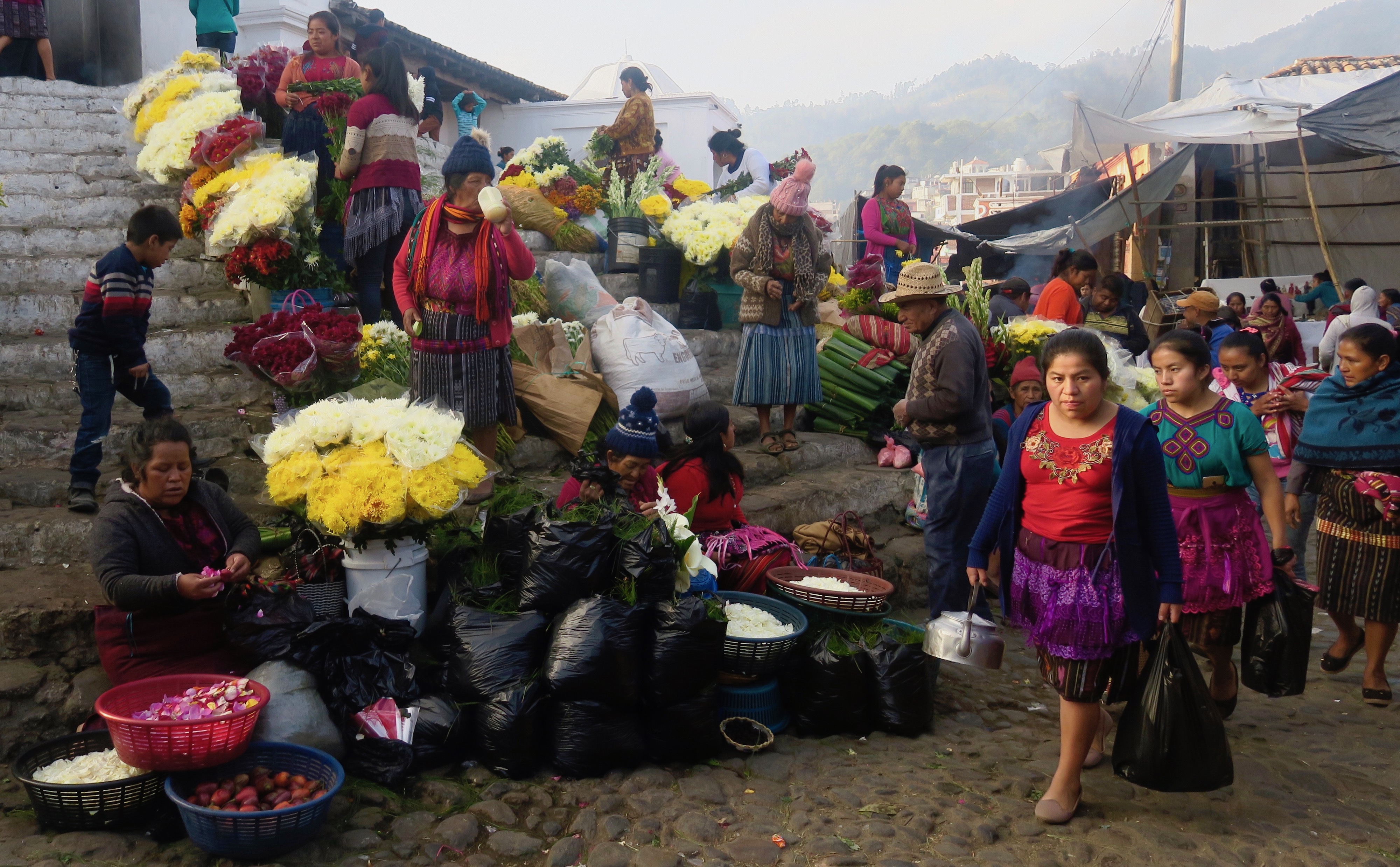
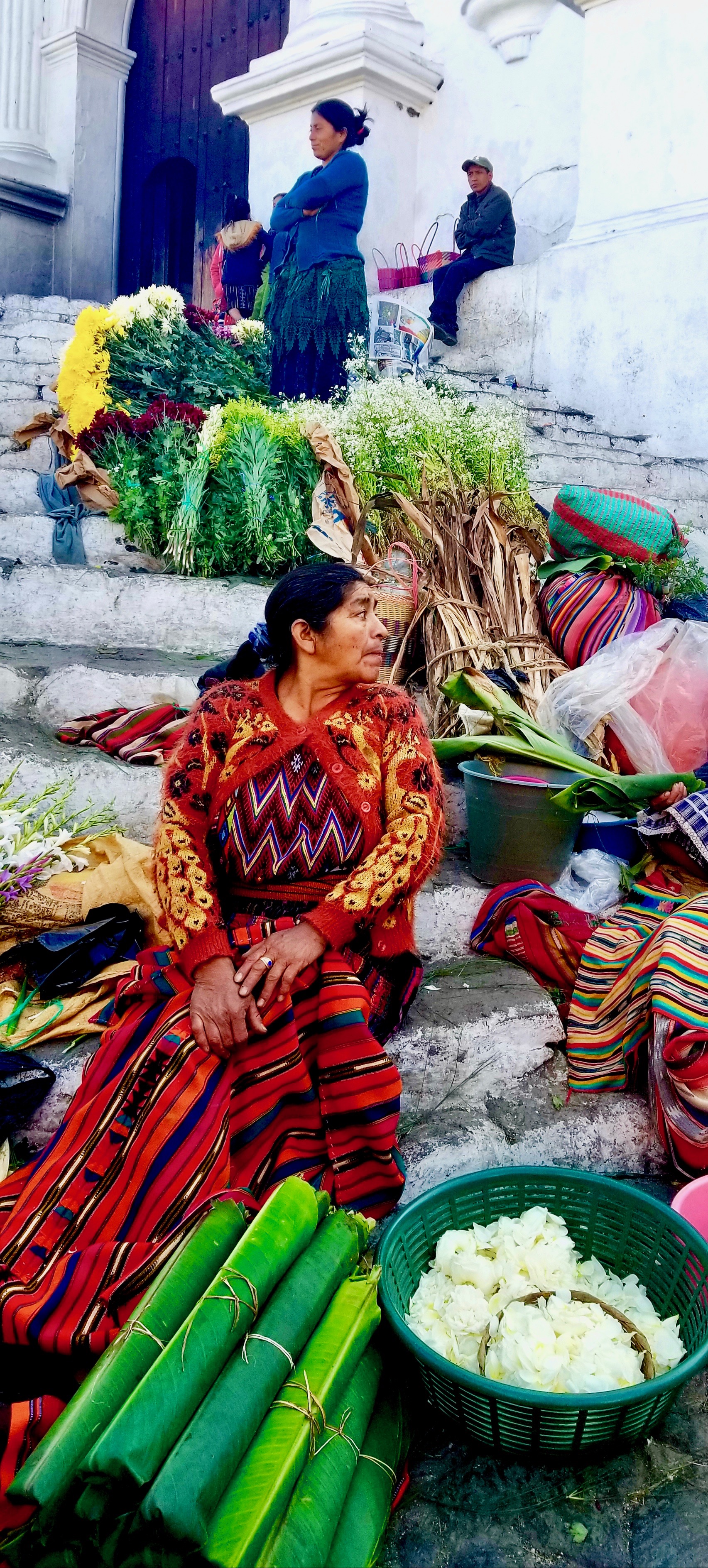
It’s not just flowers that are sold, but petals as well that are used in the Mayan sacrifice ceremonies.
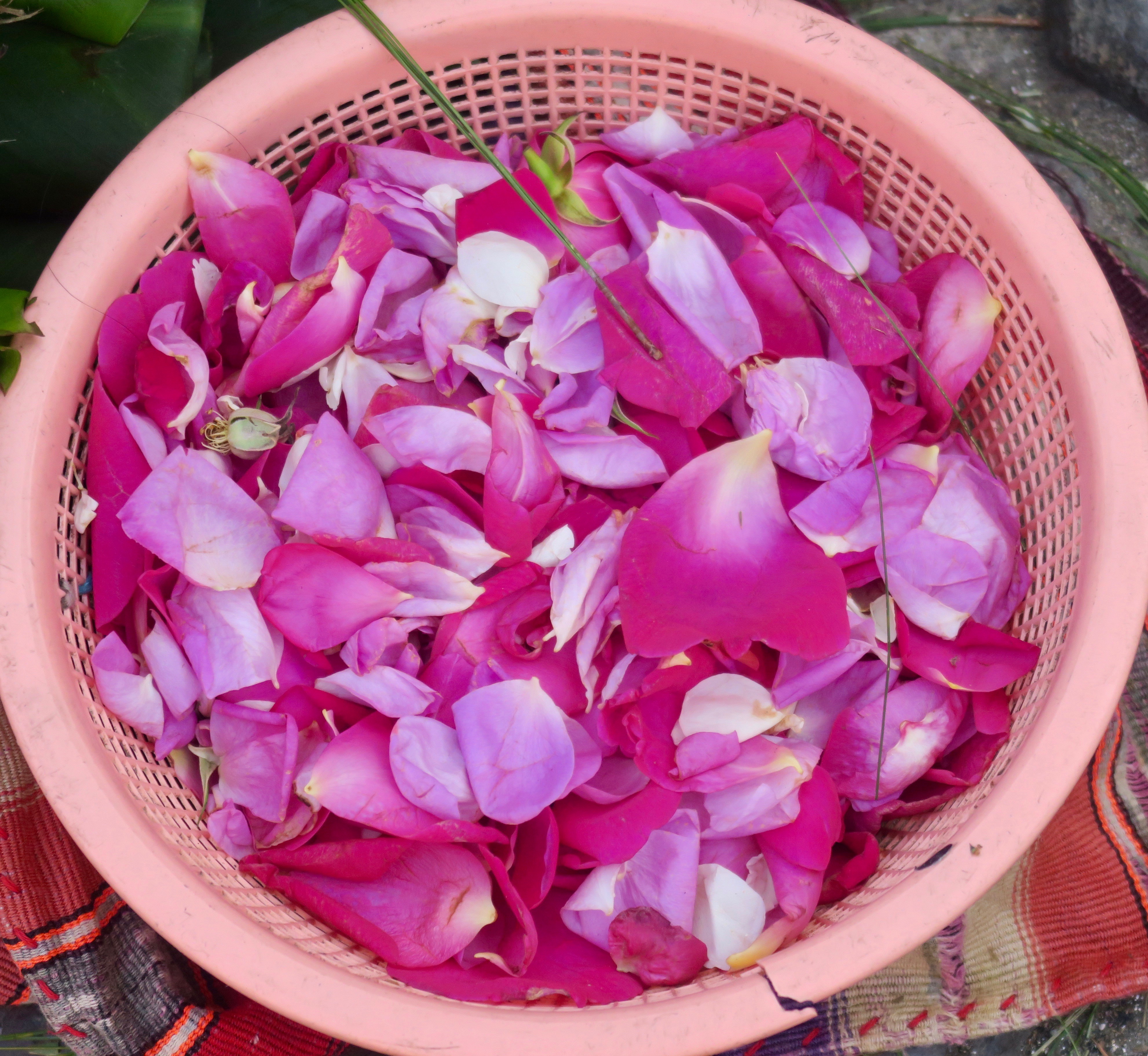
The church was built in the 1500’s on top of what had been a Mayan temple. The K’iche’ people have not forgotten that and this fellow was worshipping/praying in front of the church doors and not inside as you would expect in a purely Christian rite.
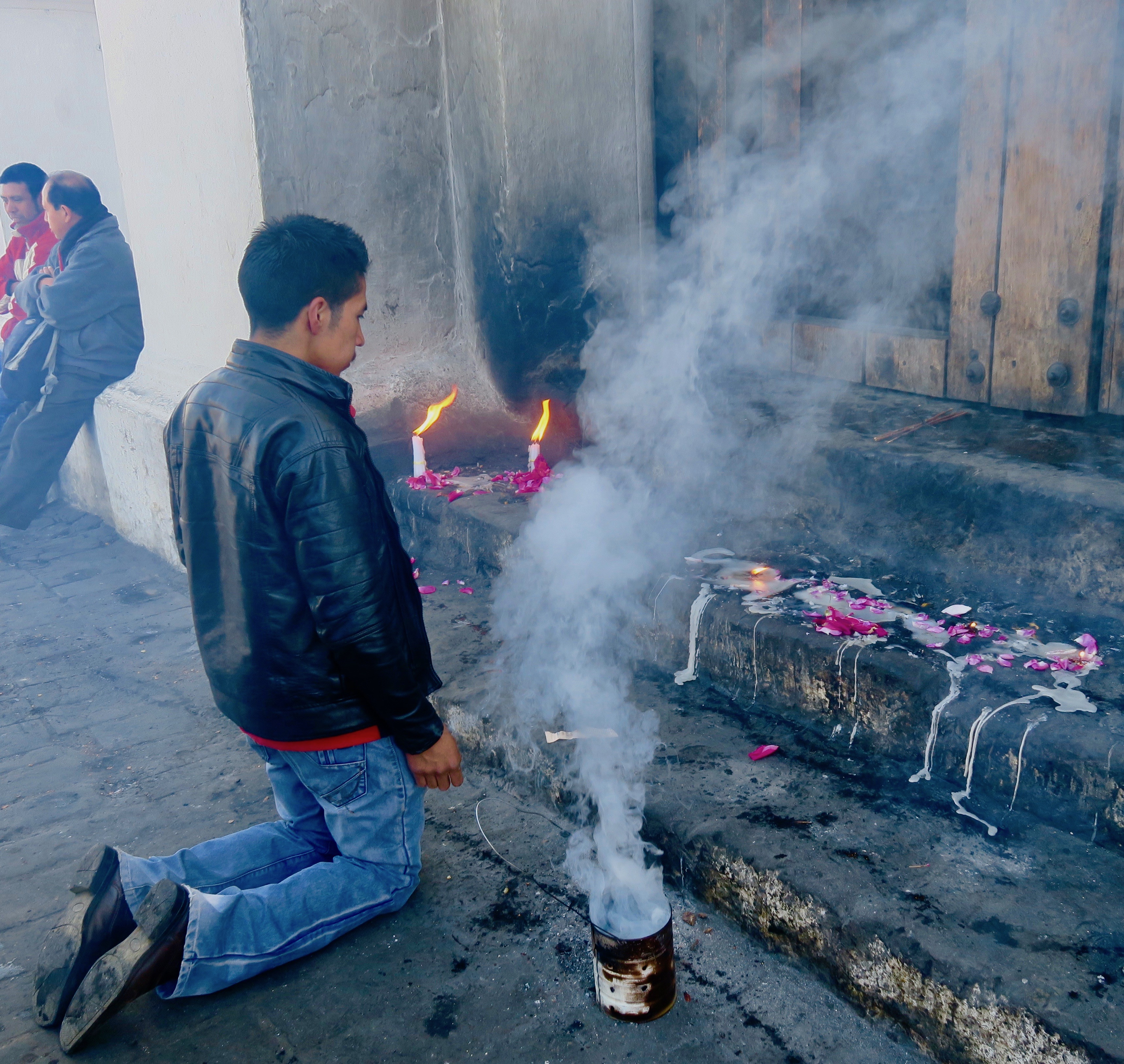
Homemade musical instruments were one of the few things that anyone made any effort to actually sell to us as obvious tourists. If one of the reasons you might want to avoid markets is harassment by over zealous vendors you don’t need to worry about that at Chichicastenango. Nobody got in our faces at any time. The contrast between what goes on in an Arab souk and here could not be greater.
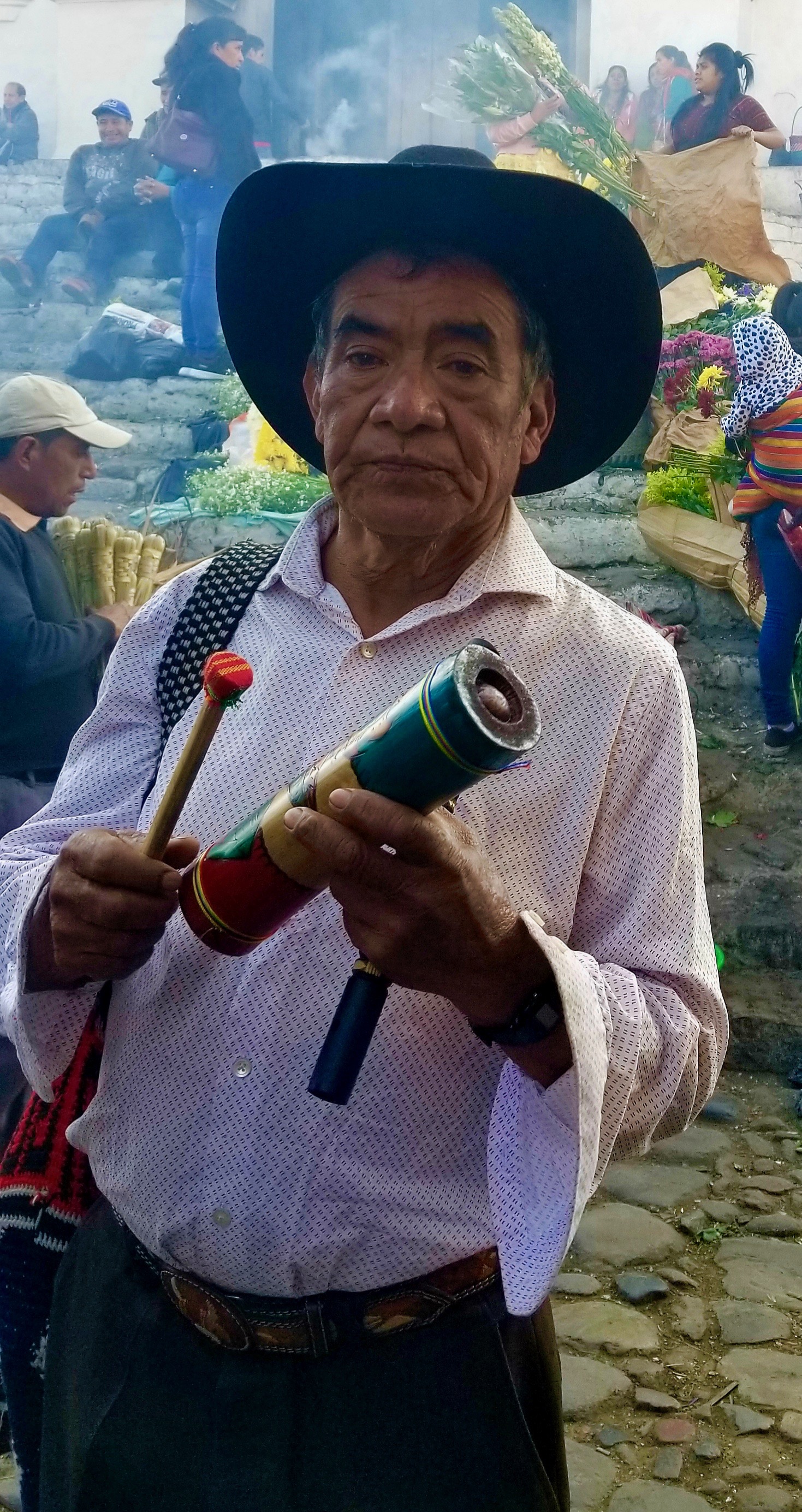
The food portion of the Chichicastenango market is in a two story building from which you can get a great view of what is going on below. This is the vegetable market, a Christmas coloured collage of green and red.
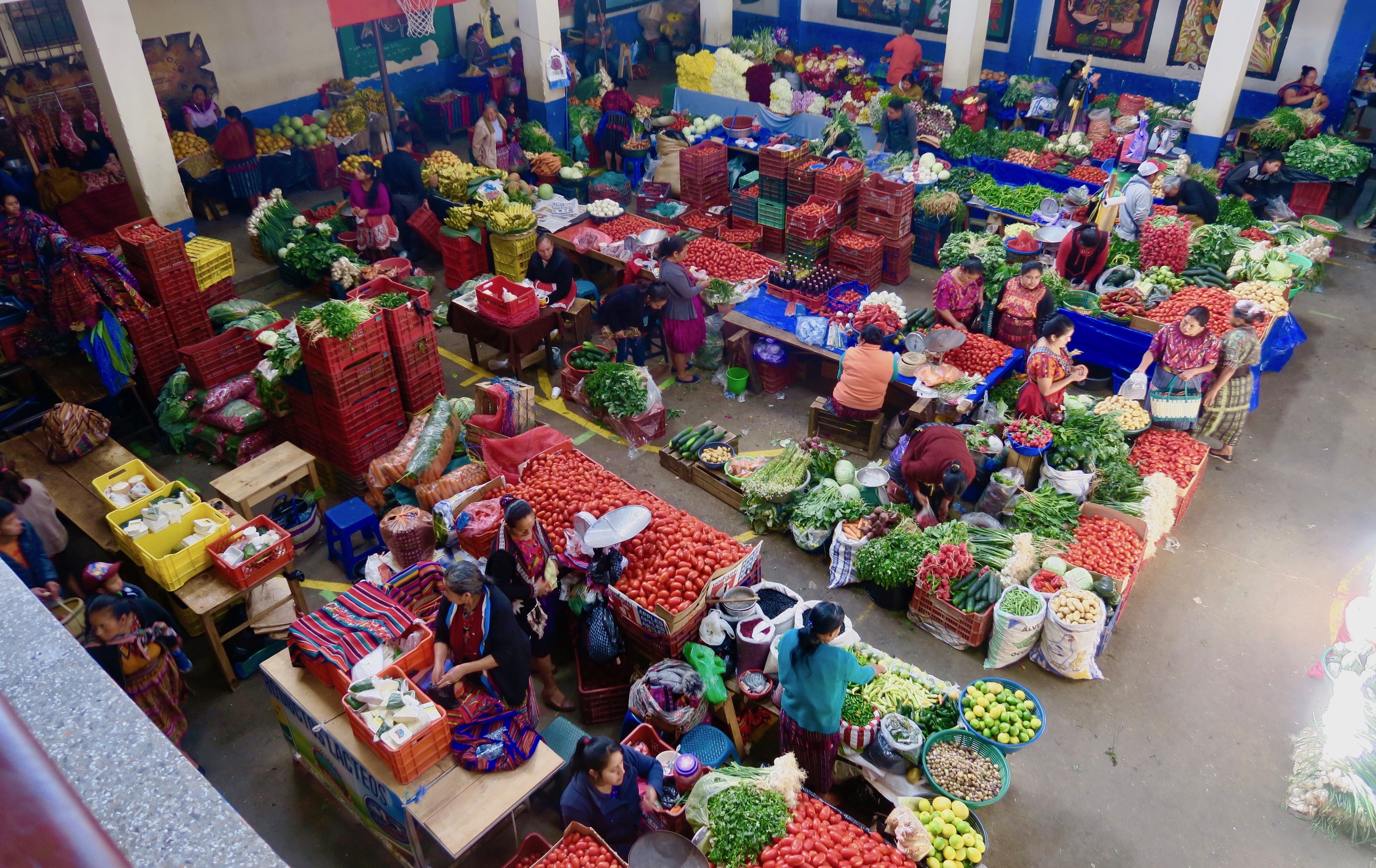
This lady did look up at me and smiled – sorta anyway.
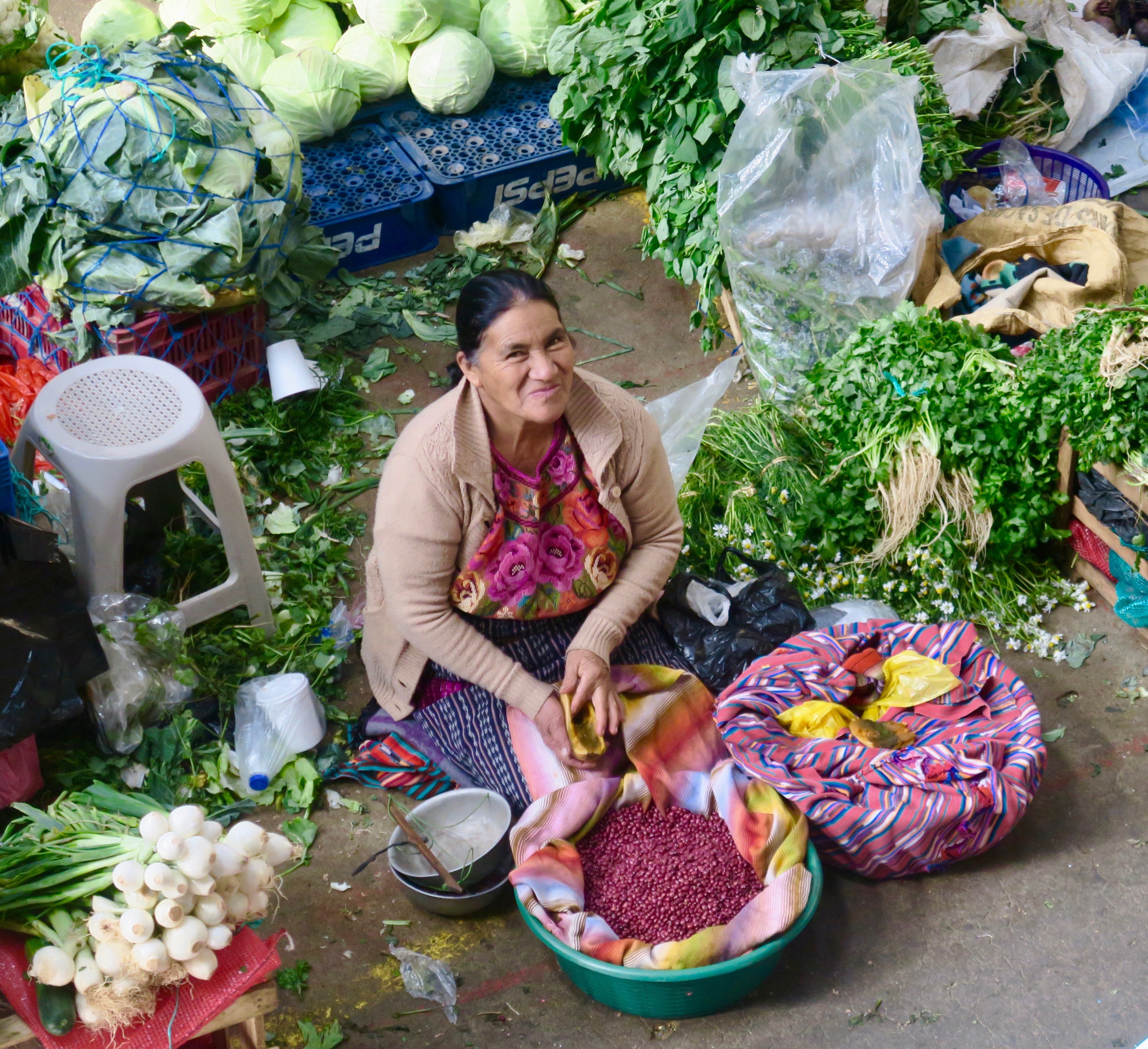
Beans anyone?

We were approached in this market by some kids selling good luck dolls and thinking back on the possible evil eye glare from the broom maker I persuaded Alison to buy some, just in case.
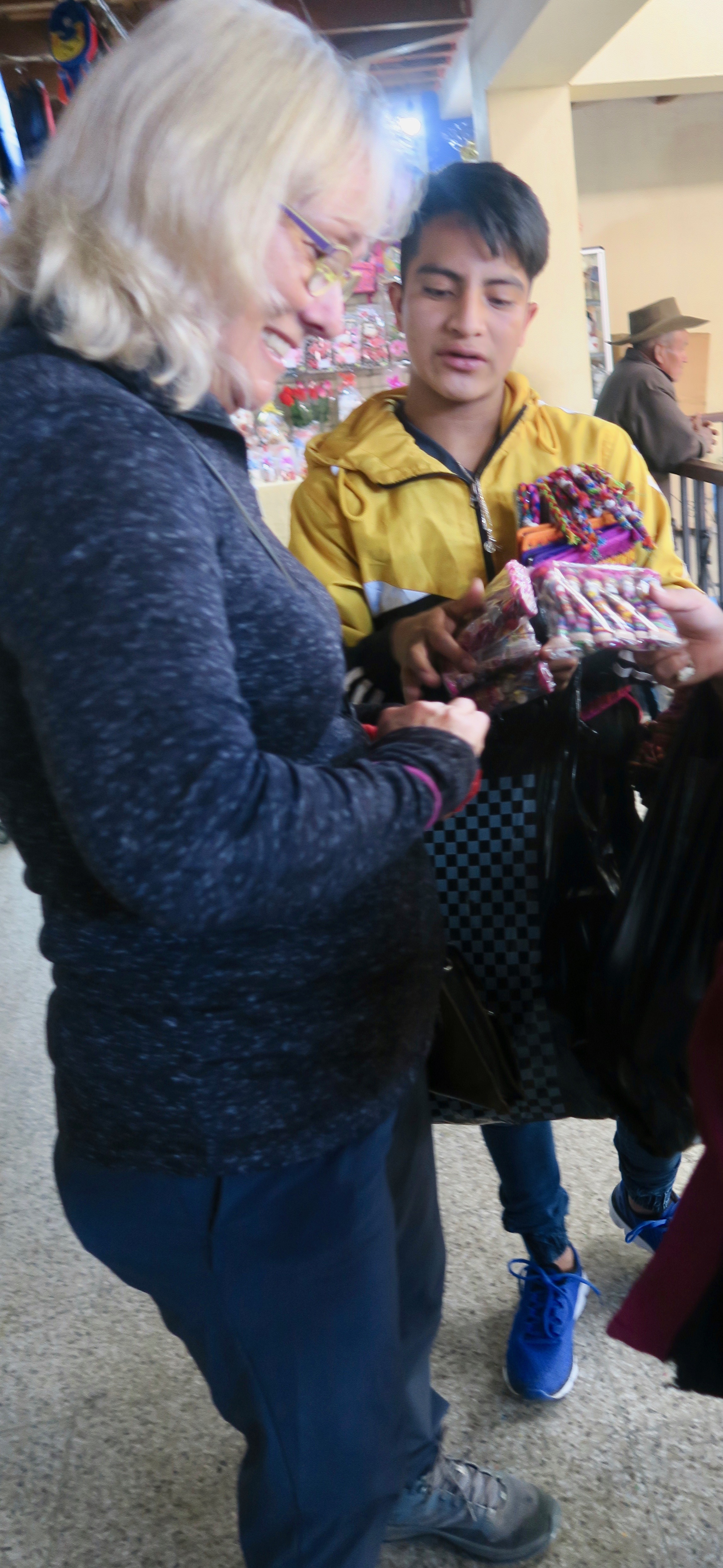
The market also has an enclosed area where hot food is served and by now we were both hungry and footsore so we stopped at one of the many family run operations that are lined up side by side under a large tent. I chose the one that had the most locals eating at and we were not disappointed. These might have been the first fries I’d had in weeks and they were great as was the chicken. I started this visit to the Chichicastenango market with chicken and that’s where I’ll end it.
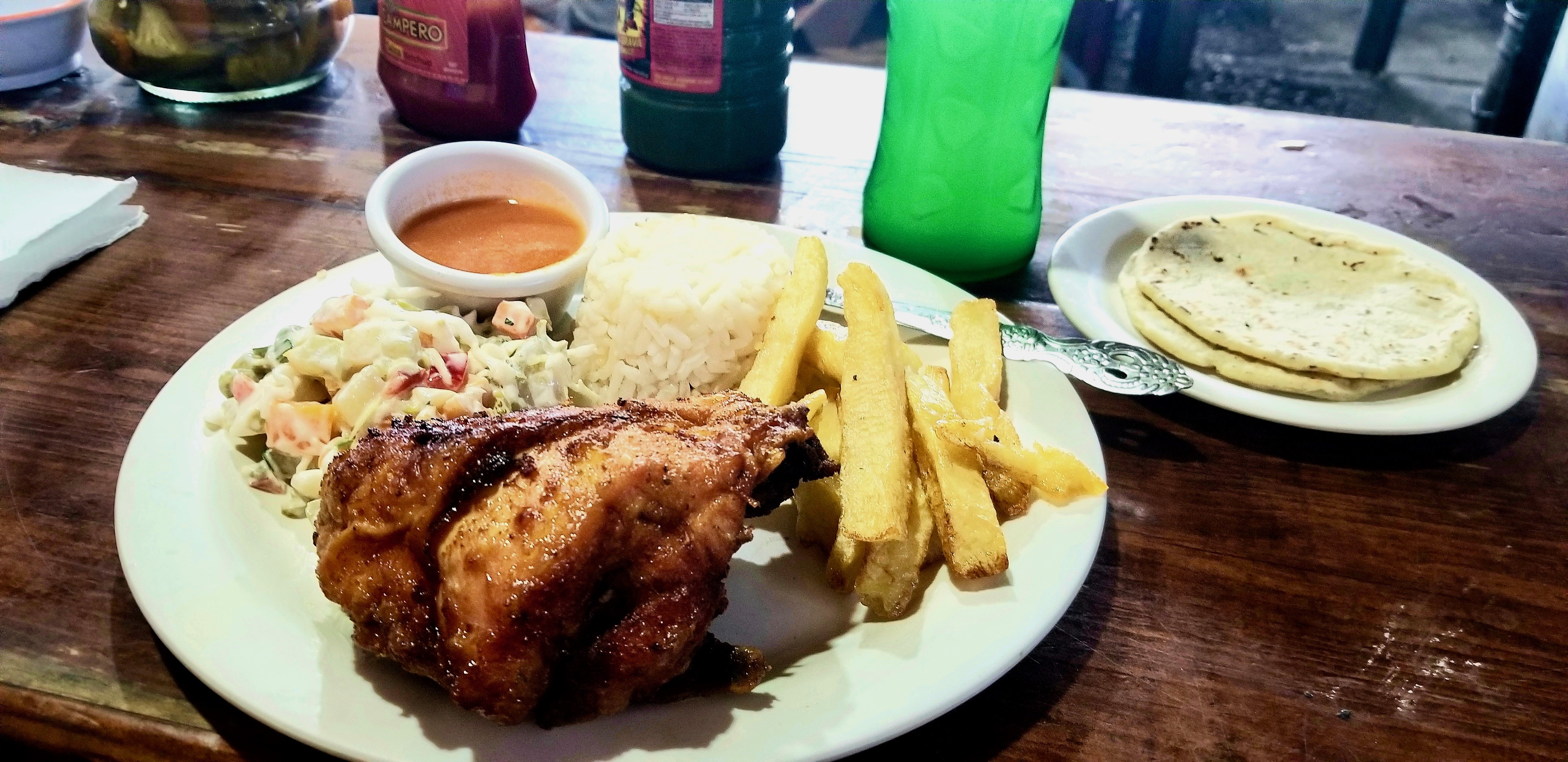
Chichicastenango is not the easiest place to get to, but more than worth the effort to be here on market day. It truly is one of the best markets I’ve ever been to.
Next we are off to one of the most beautiful lakes in the world, Atitlan, and I hope to see you there.

